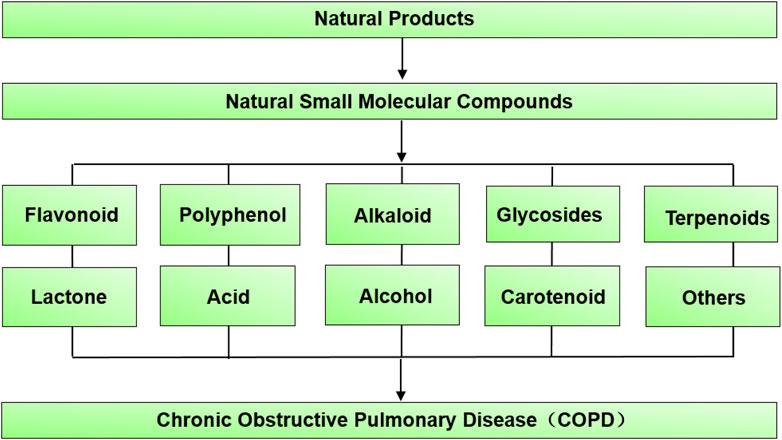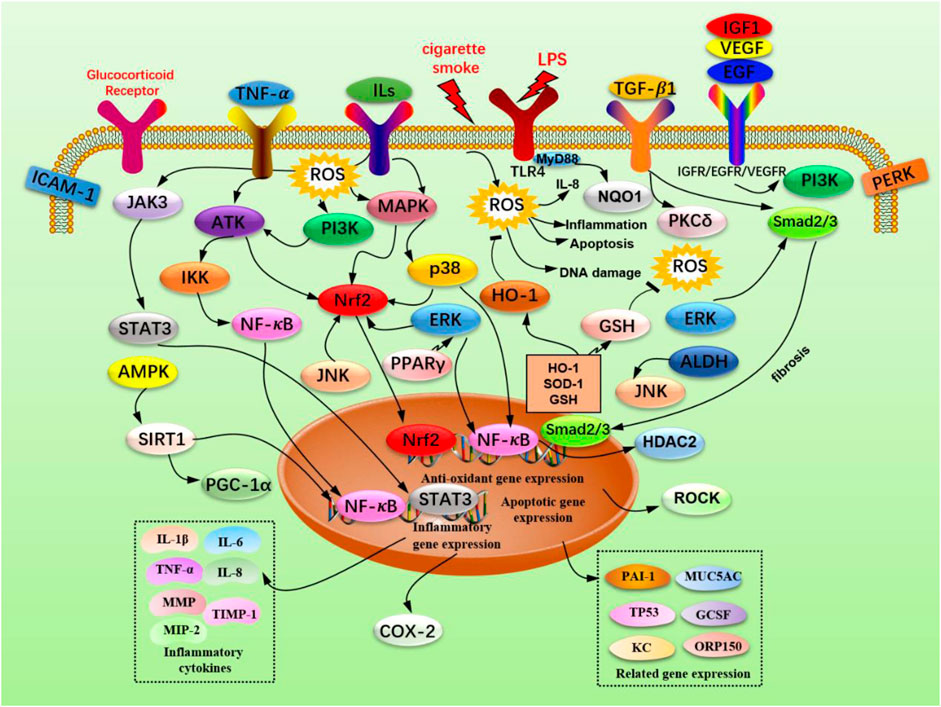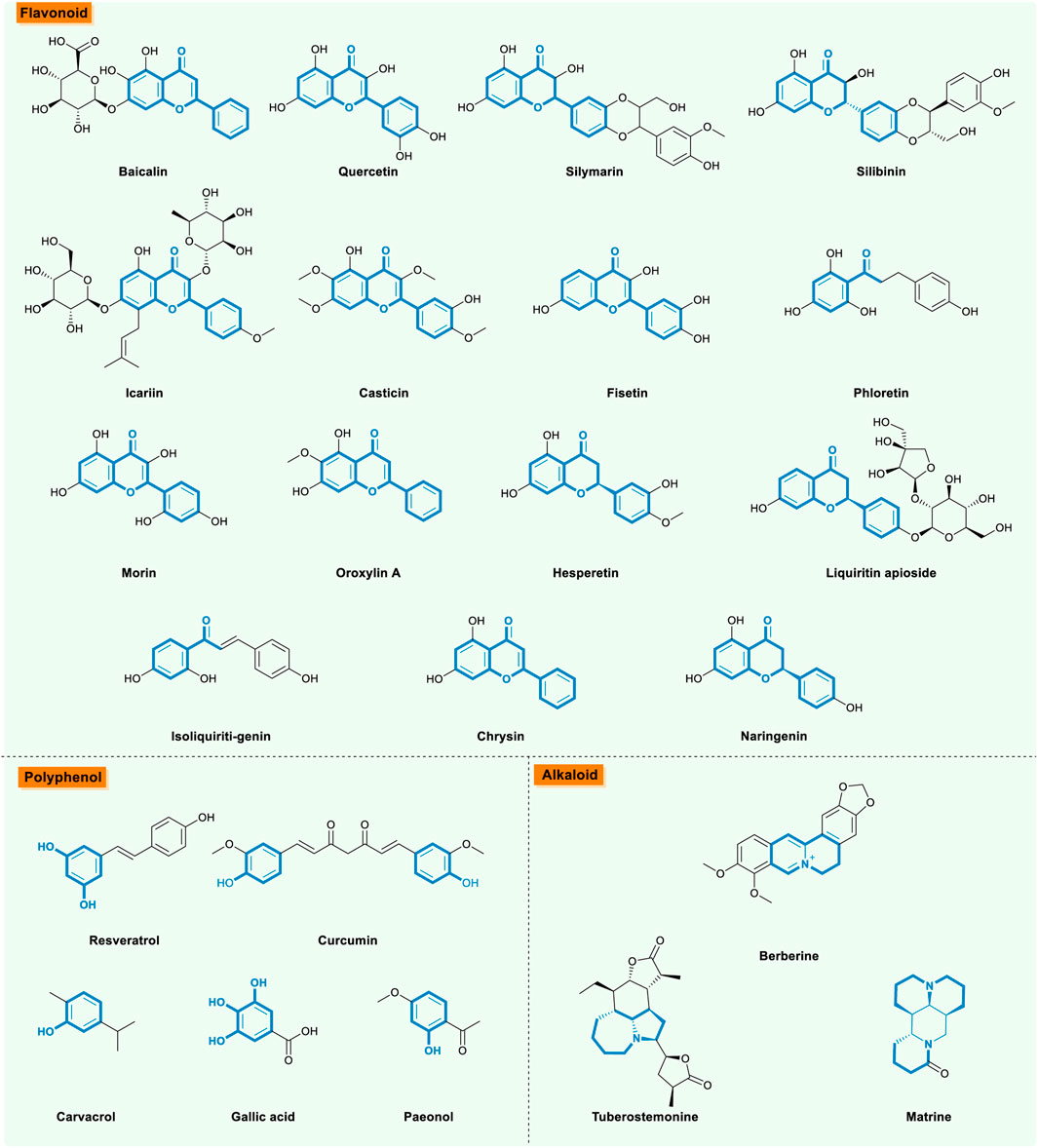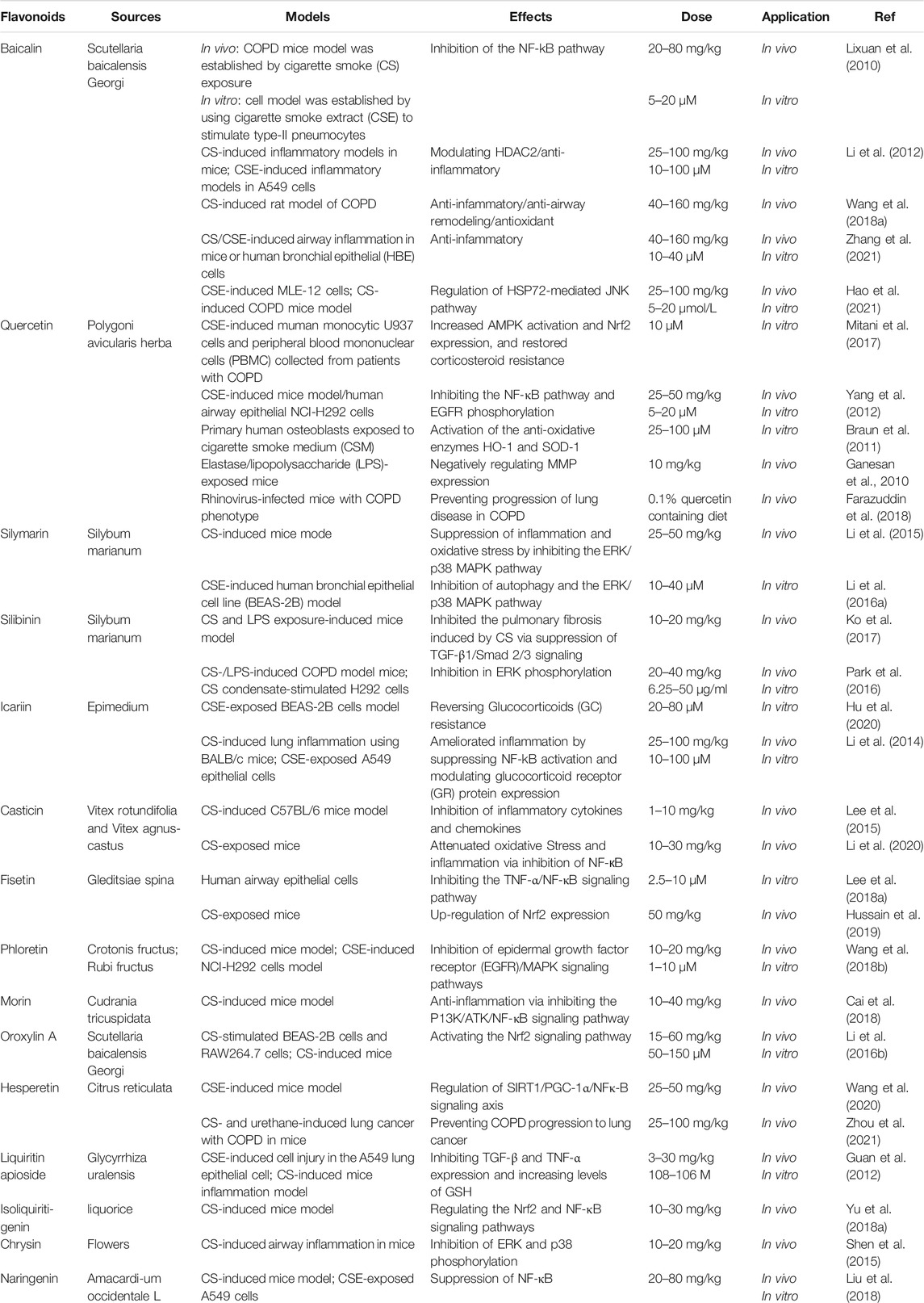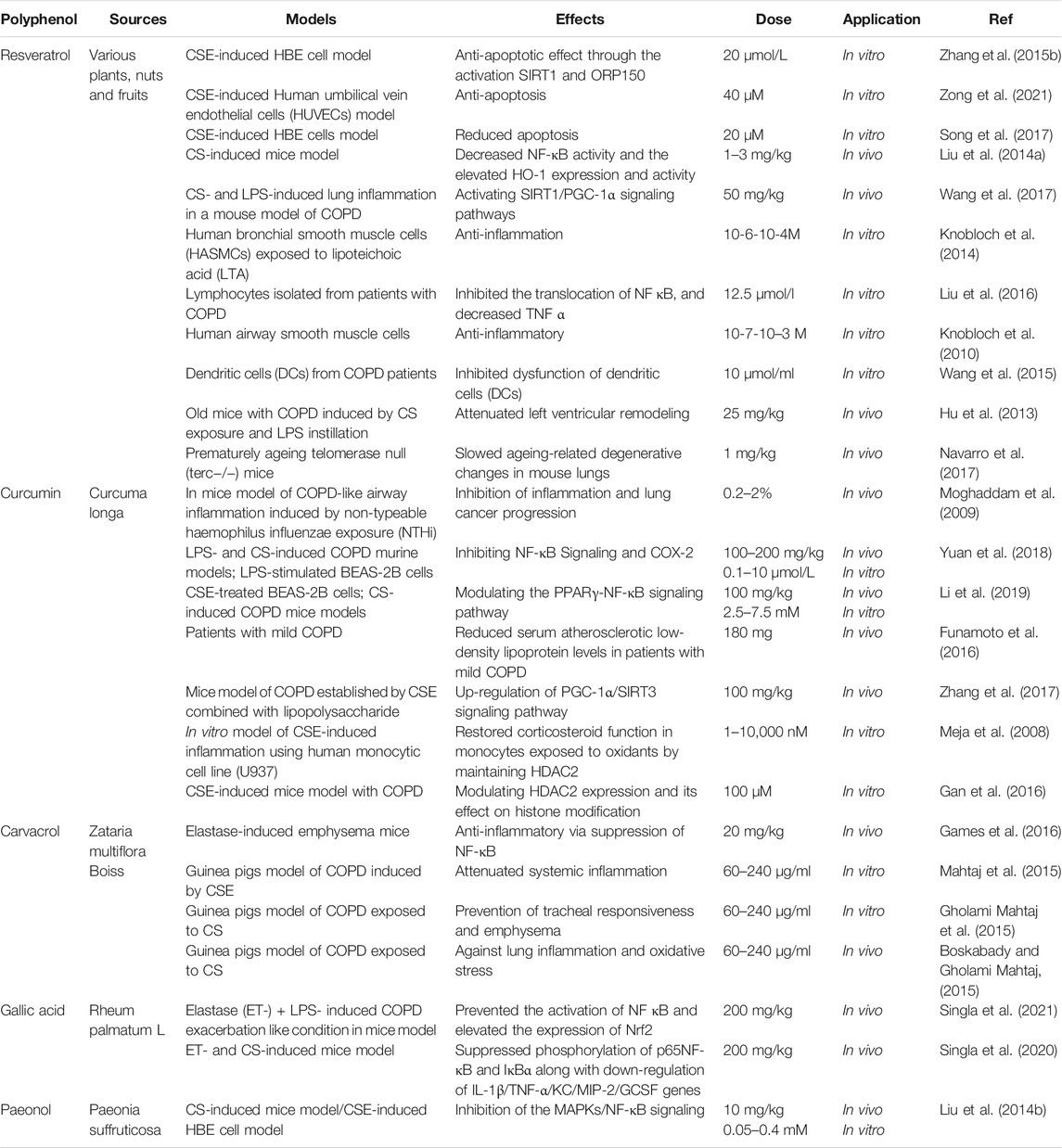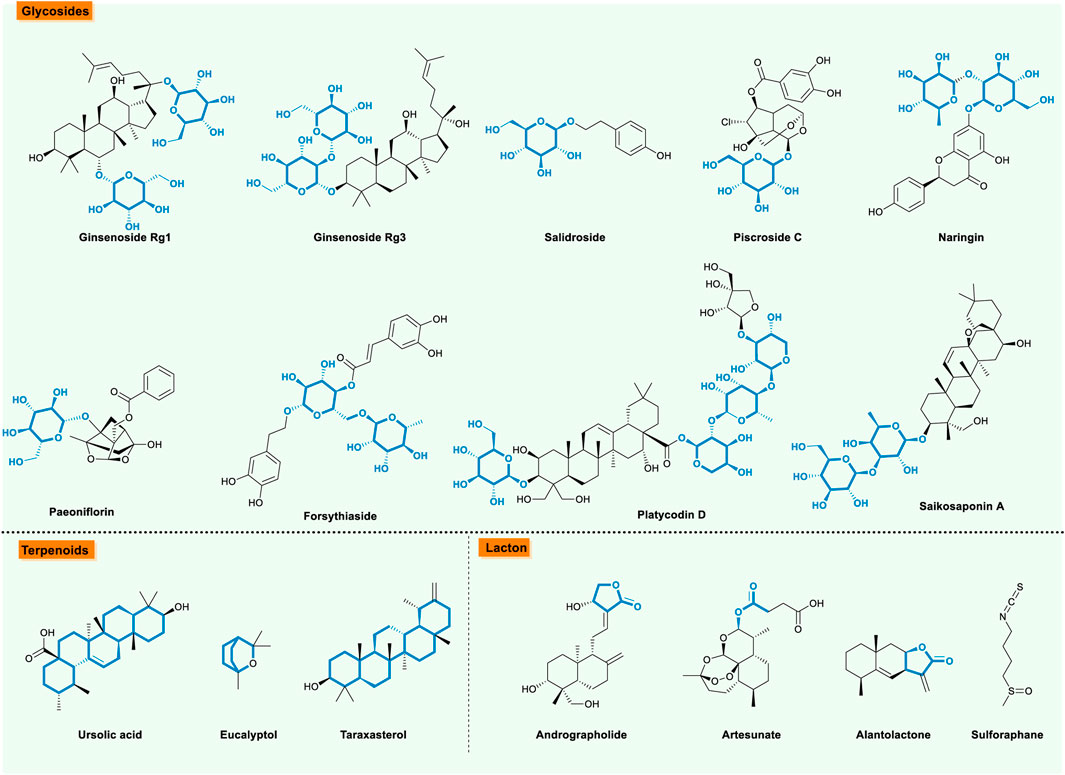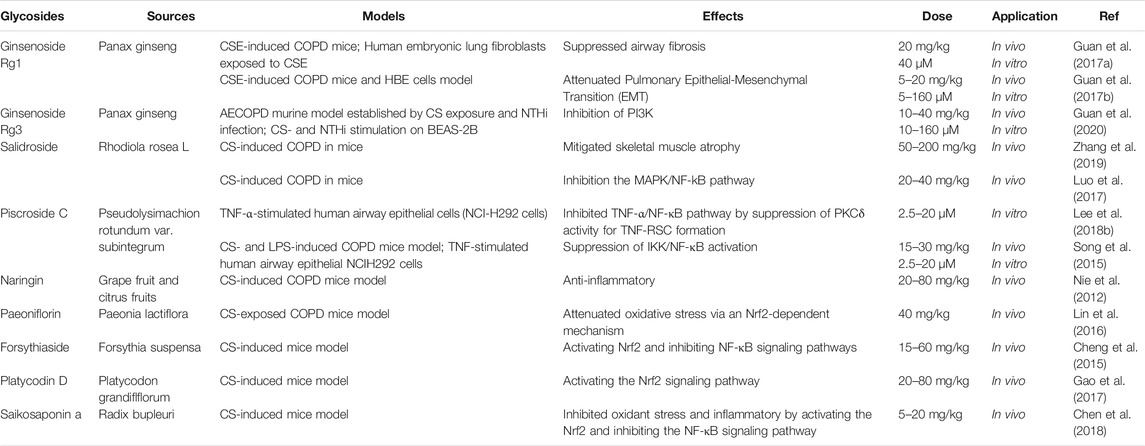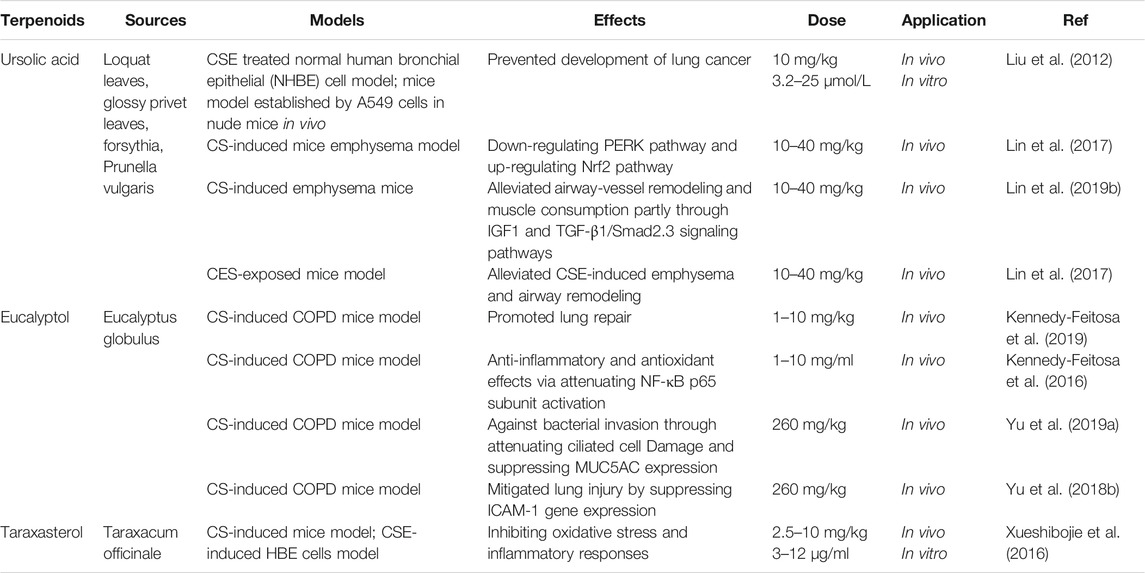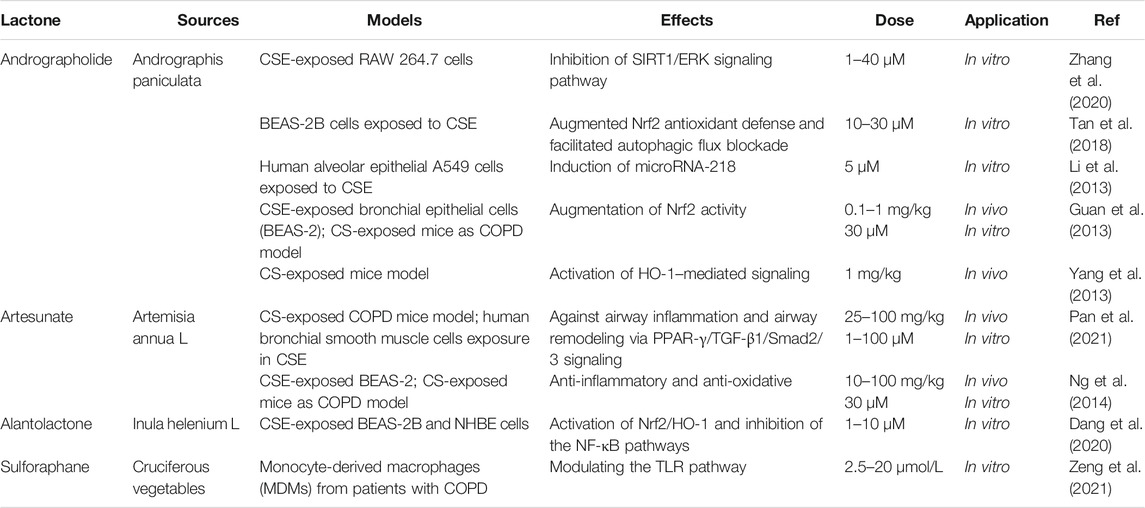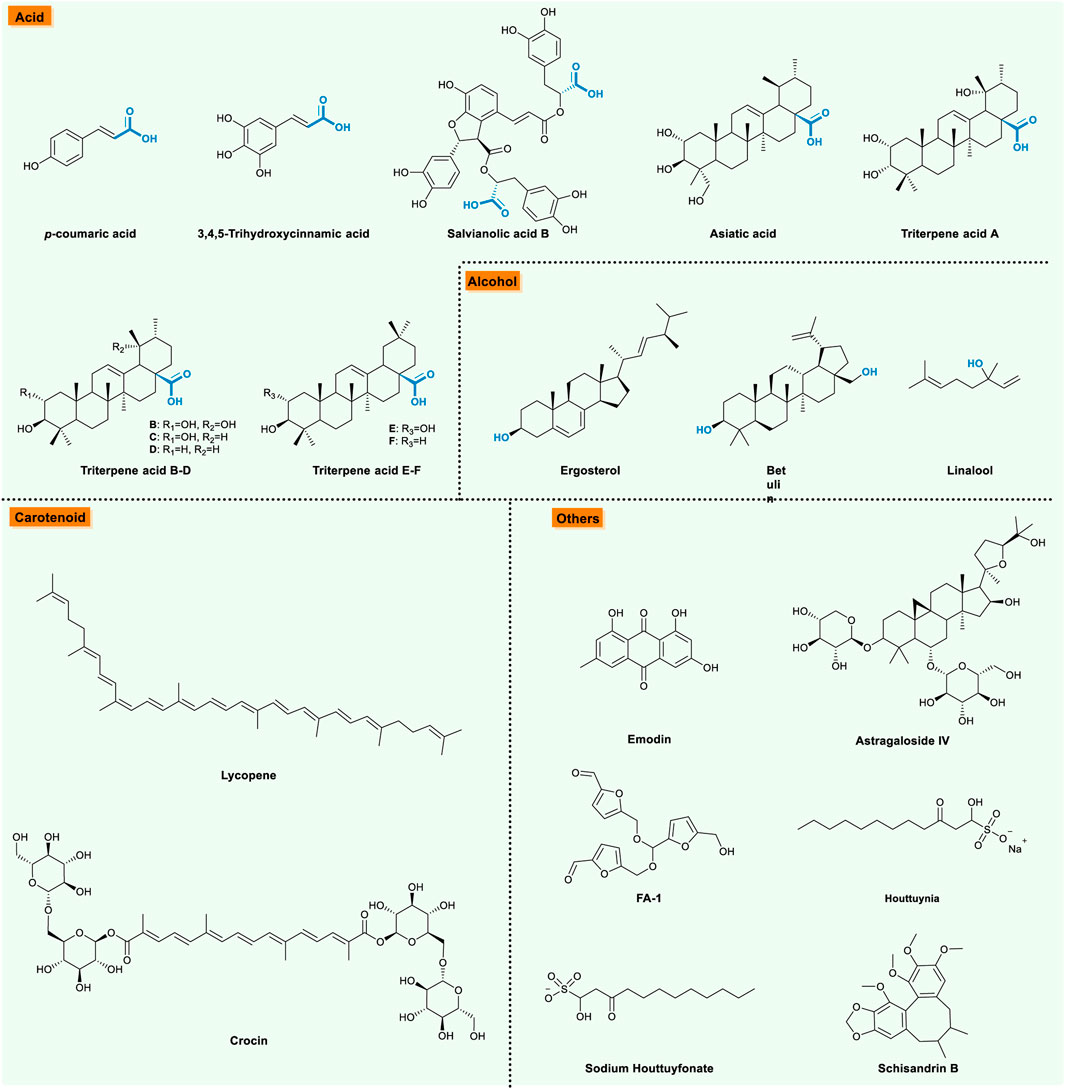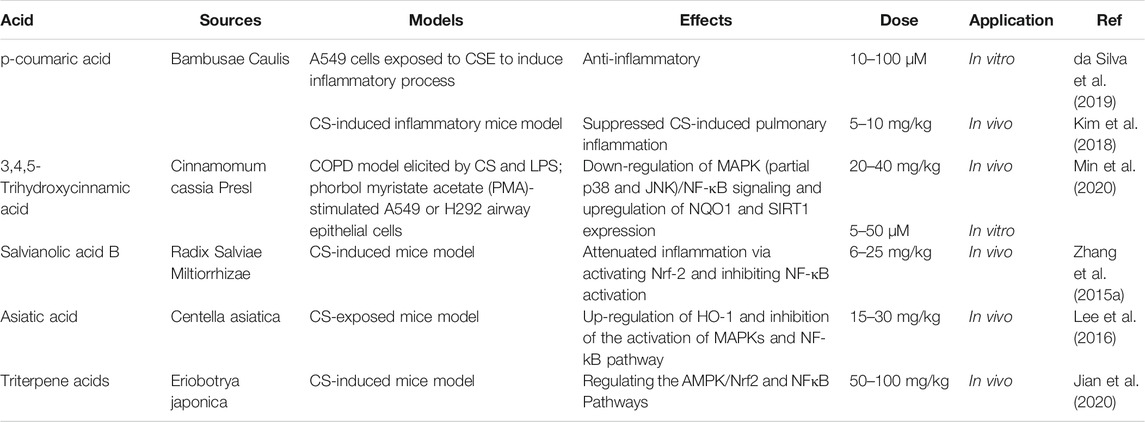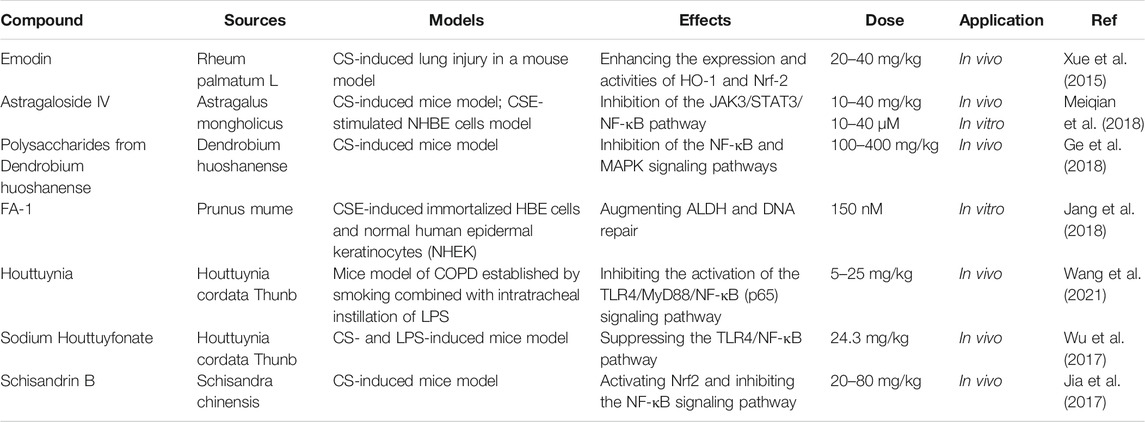- 1Department of Heart Disease of Traditional Chinese Medicine, First People’s Hospital of Zigong City, Zigong, China
- 2Department of Respiratory Medicine, Hospital of Chengdu University of Traditional Chinese Medicine, Chengdu, China
- 3Department of Respiratory and Critical Care Medicine, First People’s Hospital of Zigong City, Zigong, China
- 4Department of Combine Traditional Chinese and Western Medicine, Hospital of Chengdu University of Traditional Chinese Medicine, Chengdu, China
Chronic obstructive pulmonary disease (COPD) is one of the major diseases threatening human life and health. According to the report released by the World Health Organization (WHO) in 2020, COPD has become the third leading cause of death in the world, featuring a sustainable growth of incidence rate as well as population age. The purpose of this review focuses on the advancement of bioactive natural compounds, such as baicalin, quercetin, resveratrol, and curcumin, which demonstrate promising therapeutic/interventional effects on CODP in vitro and in vivo. Information emphasizing on COPD was systematically collected from several authoritative internet databases including Web of Science, PubMed, Elsevier, Wiley Online Library, and Europe PMC, with a combination of keywords containing “COPD” and “natural small molecular compounds”. The new evidence indicated that these valuable molecules featured unique functions in the treatment of COPD through various biological processes such as anti-inflammatory, anti-oxidant, anti-apoptosis, and anti-airway fibrosis. Moreover, we found that the promising effects of these natural compounds on COPD were mainly achieved through JAK3/STAT3/NF-κB and MAPK inflammatory signaling pathways, Nrf2 oxidative stress signaling pathway, and TGF-β1/Smad 2/3 fibrosis signaling pathway, which referenced to multiple targets like TNF-α, IL-6, IL-8, TIMP-1, MMP, AKT, JAK3, IKK, PI3K, HO-1, MAPK, P38, ERK, etc. Current challenges and future directions in this promising field are also discussed at the end of this review. For the convenience of the readers, this review is divided into ten parts according to the structures of potential natural small molecular compounds. We hope that this review brings a quick look and provides some inspiration for the research of COPD.
Introduction
Chronic obstructive pulmonary disease (COPD) is the third leading cause of mortality worldwide characterized by bronchitic and emphysematous components (Vogelmeier et al., 2020; Radicioni et al., 2021). The epidemiological survey of COPD shows that the prevalence of COPD in Spain has rapidly risen from 10.2 to 12.4%, and the proportion of men and women increases with age (Miravitlles et al., 2009). While there are about 175 million people around the world suffering from COPD, and the expenses for COPD-related treatment are as high as tens of billions of dollars every year. Only in the United States, the direct expenditure on COPD treatment in 2010 was $32 billion (Guarascio et al., 2013). It is generally believed that COPD is a series of pathophysiologic changes caused by inhaling pollutants (mainly cigarette smoke) or pathogens such as Haemophilus influenzae, Moraxella catalhalis, and Streptococcus pneumoniae (Leung et al., 2017; Szucs et al., 2019). The former can lead to airway inflammation by activating lung epithelium and inflammatory cells, while the latter can trigger pathogen-associated molecular patterns through pattern recognition receptors expressed on epithelial cells and innate immune cells, and activate nuclear factors κB (NF-κB), mitogen activated protein kinase (MAPK), phosphatidylinositol-3-kinase (PI3K), and IFN regulator signal, which lead to the production of pro-inflammatory mediators such as cytokines and chemokines, and cause a sustained harmful immune response (Sethi et al., 2006; Hallstrand et al., 2014). Subsequently, these persistent immune and inflammatory reactions will gradually introduce airway structural changes, and cause obstruction and respiratory symptoms (Rovina et al., 2013).
An increasing number of evidences indicate that inflammation serves as the turning point of vascular reconstitution in COPD, which is associated with the untimely activation of epithelial cells and innate immune cells (such as neutrophils, eosinophils, and macrophages) with inflammatory mediators (i.e. inflammatory peptides, lipid mediators, growth factors, reactive oxygen and nitrogen species, chemokines cytokines, and cellular proteases) (Barnes, 2016; Kuźnar-Kamińska et al., 2018; Capron et al., 2019). Recent studies have shown that numerous natural compounds possess obvious therapeutic effects on the symptoms of COPD model animals (Figure 1). For example, not only can quercetin, a
representation of flavonoid, significantly reduce pulmonary oxidative stress, inflammation, and mucus production in COPD model animals, but also improve corticosteroid resistance by promoting AMPK activation and Nrf2 expression (Ganesan et al., 2010; Braun et al., 2011; Mitani et al., 2017). The polyphenol compound curcumin enables the promotion of airway inflammation and airway remodeling in COPD model animals by regulating the NF-κB signaling pathway (Yuan et al., 2018), and improves skeletal muscle dysfunction by up-regulating the PGC-1α/SIRT3 pathway (Zhang et al., 2017). In addition, curcumin demonstrates an inhibition on the expression of pro-inflammatory genes and the level of chemokines, and regulations towards corticosteroid resistance (Gan et al., 2016). Given these multiple effects on improving COPD symptoms, a prospective review regarding the advancements of potential natural small molecular compounds is highly needed. However, to the best of our knowledge, less attention has been paid in this promising field despite scattered summaries in several reviews (Goncalves and Romeiro, 2019). The main purpose of this review concentrates on summarizing the latest and representative information on therapeutic/interventional effects of reported natural compounds on COPD in recent years (Figure 2), to excavate the potential of these bioactive molecules and furnish basic information for research in the future, as well as provide a useful supplement to reviews related to COPD (Figure 3).
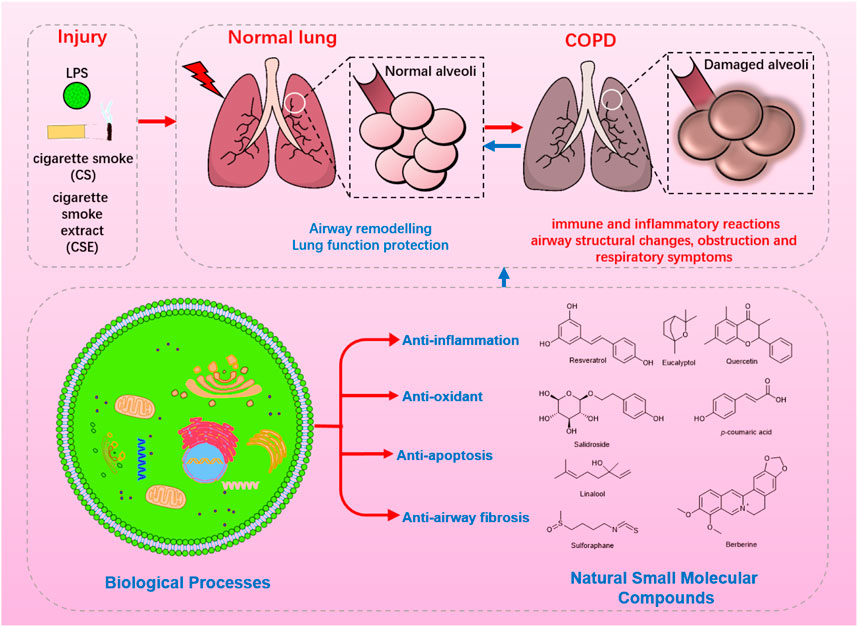
FIGURE 2. The biological processes and mechanisms of natural small molecular compounds in the treatment of COPD.
Flavonoid
Flavonoids possess a variety of biological properties such as anti-inflammatory, anti-apoptosis, and anti-oxidant properties to improve COPD symptoms (Table 1; Figure 4). Baicalin is a flavonoid compound isolated from the root of Scutellaria baicalensis Georgi, possessing multiple biological activities, such as anti-inflammatory and anti-oxidant properties. To clarify the effects of baicalin on COPD, the mice and cell models were established by using cigarette smoke (CS) and cigarette smoke extract (CSE), respectively. Results showed that baicalin could regulate pro-infammatory and anti-infammatory balance and exert great lung function protection on COPD (Lixuan et al., 2010; Li et al., 2012; Wang et al., 2018a; Hao et al., 2021; Zhang et al., 2021). The anti-inflammatory effect was likely achieved via inhibiting the nuclear factor-kappa B(NF-κB) activation (Lixuan et al., 2010), up-regulating histone deacetylase 2(HDAC2) protein expression, along with inhibiting HDAC2 phosphorylation (enhancing HDAC2 activity) (Li et al., 2012), and modulating HDAC2/NF-κB/PAI-1 signaling pathways (Zhang et al., 2021).
As a flavonoid abundant in fruits and vegetables, quercetin has attracted much attention for its beneficial health effects including anti-oxidant and anti-inflammation activity. It was found that quercetin successfully reduced oxidative stress, lung inflammation, and mucus production via negating MMP expression in elastase/LPS-exposed mice (Ganesan et al., 2010), or via inhibiting the NF-κB pathway and EGFR phosphorylation both in the CS/CSE-induced mice model and NCI-H292 cell model (Yang et al., 2012). Smokers frequently suffer from impaired fracture healing often due to poor bone quality and stability induced by increasing formation of reactive oxygen species (ROS). One research found that quercetin could protect primary human osteoblasts from the toxic effects of smoking through activation of the anti-oxidative enzymes HO-1 and SOD-1 (Braun et al., 2011). Besides, acute exacerbations are the major cause of morbidity and mortality in patients with COPD, Mohammad Farazuddin et al. disclosed that quercetin effectively mitigated rhinovirus-induced progression of lung disease on COPD mice models (Farazuddin et al., 2018). To remove a major barrier known as corticosteroid resistance for the effective treatment of COPD, quercetin also provided access to restore corticosteroid sensitivity in cells from patients with COPD via the mechanism of increasing AMPK activation and Nrf2 expression (Mitani et al., 2017).
Separated from the milk thistle (Silybum marianum), silymarin attenuated inflammation and oxidative stress induced by CS/CSE on mice and in the BEAS-2B cell (human bronchial epithelial cells). The anti-inflammatory and anti-oxidant effects of silymarin might be related to the inhibition of autophagy and ERK/p38 MAPK pathway (Li et al., 2015; Li D. et al., 2016). Silibinin, an active constitute of silymarin, could markedly reduce the production of fibrotic mediators in CS + LPS-exposed mice via suppression of TGF-β1/Smad 2/3 signaling (Ko et al., 2017), as well as clearly decrease the pro-inflammatory mediators and airway mucus production expression in CS condensate-stimulated H292 cells and COPD mice model via the inhibition in ERK phosphorylation (Park et al., 2016). Among dihydroflavones, Naringenin, hesperetin, and liquiritin apioside (LA) also exhibited positive effects on COPD, among which hesperetin could not only effectively alleviate inflammation and oxidative stress responses in CES-induced COPD mice by virtue of NAD-dependent protein deacetylase sirtuin-1(SIRT1)/PGC-1α/NF-κB signaling axis (Wang et al., 2020), but also suppress the protein expression of AKT1, IL6, VEGFA, and MMP9 and up-regulate TP53 to reduce the risk of COPD progressing to lung cancer (Zhou et al., 2021). Besides, LA offered protection to lung epithelial cell from CS-induced injuries by inhibiting the transforming growth factor-β (TGF-β) and tumor necrosis factor-α (TNF-α) expression and increasing anti-oxidative levels of glutathione (GSH) (Guan et al., 2012). Notably, naringenin smoothly attenuated inflammation in COPD on CS-induced mice models via suppressing NF-κB pathway (Liu et al., 2018).
As a major constituent of flavonoids isolated from the herb Epimedium, icariin exerted a therapeutic effect in numerous chronic inflammatory diseases. However, COPD tends to be glucocorticoid (GC) resistant, and Lingli Hu et al. noted that icariin was able to decrease CSE-induced inflammation, airway remodeling, and ROS production by mitigating GC resistance in CSE-induced BEAS-2B cells models (Hu et al., 2020). Besides, icariin owned anti-inflammatory effects on CS-induced inflammatory models, which was possibly achieved by suppressing NF-κB activation and modulating the glucocorticoid receptor (GR) protein expression (Li et al., 2014). Except for icariin suppressing NF-κB activation, casticin, which was a poly-methylflavone obtained from Vitex species such as Vitex rotundifolia and Vitex agnus-castus, was found possessing significant effects on attenuating oxidative stress and lung inflammation induced by CS (Lee et al., 2015), which was related to the inhibition of NF-ĸB pathway (Li et al., 2020). Apart from the extractions from herbs, the natural flavonoid fisetin (3,7,3′,4′-tetrahydroxyflavone) demonstrated its abilities on effectively alleviating lung oxidative stress and inflammation induced by the powerful pro-oxidant CS through the incremental expression of Nrf2 as well as its downstream target anti-oxidant gene (Hussain et al., 2019). Furthermore, Seoghyun Lee et al. found that fisetin acted as a good drug candidate for improving the lung function of patients with COPD by suppressing the TNF-α/NF-κB signaling cascade (Lee S. et al., 2018). Additionally, the valuable chalcone phloretin existing in Crotonis fructus and Rubi fructus featured diverse biologic properties. Hao Wang et al. reported that phloretin-based pre-treatment remarkably blocked mucins secretion, inflammatory cytokine release, and inflammatory cell infiltration on CS-induced mice models, as well as an interruption of CSE-induced expression of MUC5AC and IL-1β in NCI-H292 bronchial epithelial cells. Those previously mentioned protections were possibly achieved by attenuating the functions of P38, ERK and EGFR in vivo and in vitro (Wang et al., 2018b).
Despite the similarity of morin, oroxylin A and chrysin on structures, the three natural products provided positive effects on COPD through different mechanisms. Briefly, morin (3,5,7,2′,4′-pentahydroxyflavone), a major component of a traditional medicinal herb Cudrania tricuspidata, demonstrated protective effects on CS-induced lung inflammation probably by blocking P13K/ATK/NF-κB signaling pathway (Cai et al., 2018); Known as a natural flavonoid extracted from the traditional herb Scutellaria baicalensis Georgi, oroxylin A attenuated CS-induced lung histopathologic changes, expression of cytokines TNF-α, IL-1β in a mice model with a dose-dependent manner, as well as significantly up-regulated Nrf2 expression in CSE-stimulated cells (Li J. et al., 2016). Furthermore, as a naturally-occurring flavone commonly found in flowers, chrysin effectively inhibited CSE-induced airway inflammation in mice through inhibition of ERK and p38 phosphorylation (Shen et al., 2015). Beyond these molecules mentioned previously, as a variant of flavonoid, isoliquiriti-genin (ILG) derived from the root of liquorice was reported to antagonize COPD on CS-induced mice model by suppressing inflammatory and oxidative stress through up-regulating the expression of Nrf2 and down-regulating the expression of NF-κB signaling pathways (Yu D. et al., 2018).
Polyphenol
Polyphenol belongs to a group of chemical substances in plants featuring multiple phenol groups (Table 2; Figure 4). Resveratrol (3,4′,5-trihydroxystilbene; RESV), a natural polyphenol phytoalexin identified from a variety of plant species, exhibited a protective effect against CSE-induced apoptosis in cells (Zhang L. et al., 2015; Song et al., 2017; Zong et al., 2021). The anti-apoptotic effect may be exerted through the activation of a pathway involving SIRT1 and ORP150 in CSE-induced HBEpC cell (Zhang L. et al., 2015), and activation of Notch1 signaling mediated autophagy in CSE-induced HUVECs models (Zong et al., 2021), or via up-regulating mitofusin 2 (MFN2) in a CSE-induced HBEpC cell (Song et al., 2017). Recently, studies have found that resveratrol could protect against oxidative damage and pulmonary inflammation on the COPD mice model (Liu et al., 2014a; Wang et al., 2017), where the mechanism might be related with decreasing NF-κB activity and elevated HO-1 expression, and activating the SIRT1/PGC-1α signaling pathways (Wang et al., 2017). Alongside the functions mentioned previously, resveratrol could not only effectively attenuate the release of inflammatory cytokines from human bronchial smooth muscle cells (HASMCs) in COPD (Knobloch et al., 2010; Knobloch et al., 2014), but also inhibit the NF-κB, TNF-α, and MMP-9-associated pathways, simultaneously slowing the dysfunction of dendritic cells (DCs) in patients with COPD (Wang et al., 2015; Liu et al., 2016). These findings proved that resveratrol was able to ameliorate cardiac oxidation stress and apoptosis and increase the expression of SIRT1, as well as attenuate left ventricular remodeling, while these factors might assist the left ventricular impairment process in old mice with COPD induced by CS and LPS exposure. (Hu et al., 2013). Overall, resveratrol prophylaxis by inhalation is a potential approach for slowing down ageing-related deterioration of the lung function and structure in prematurely ageing telomerase null (terc−/−) mice, which could be developed as a potentially novel approach to maintaining lung health, prior to the irreversible onset of ageing-related structural and functional decline in the lungs (Navarro et al., 2017).
Curcumin [(1E,6E)-1,7-bis(4-hydroxy-3-methoxyphenyl)hepta-1,6-diene-3,5-dione] is a naturally occurring polyphenolic phytochemical isolated from the rhizome of the medicinal plant Curcuma longa. Dietary administration of curcumin effectively suppressed NTHi-induced COPD-like airway inflammation and lung cancer progression in mice (Moghaddam et al., 2009). Curcumin could also attenuate CS-induced inflammation both in vivo and in vitro by modulating the PPARγ-NF-κB signaling pathway (Li et al., 2019), along with attenuating airway inflammation and remodeling by blocking NF-κB and COX-2 signaling on CS-induced COPD mice (Yuan et al., 2018). Theracurmin®, a highly absorptive curcumin, with improved bioavailability using a drug delivery system, reduced levels of the atherosclerotic α1-antitrypsin-low-density lipoprotein (AT-LDL) complex. This result suggested that curcumin was beneficial to prevent the development of vascular events in patients with COPD (Funamoto et al., 2016). Among the multiple symptoms induced by COPD, skeletal muscle
dysfunction is one of the most extrapulmonary symptoms in COPD patients, where mitochondria manifestation plays an important role in the duration. Therefore, protecting mitochondria from injury is crucial to prophylaxis skeletal muscle dysfunction during the progression of COPD. Under this context, Ming Zhang et al. found that curcumin smoothly attenuated skeletal muscle mitochondrial impairment in COPD mice via up-regulating the PGC-1α/SIRT3 signaling pathway (Zhang et al., 2017). In addition, recent studies have suggested that histone modification showed a positive impact on various aspects associated with the progression of COPD where histone deacetylase 2 (HDAC2) could suppress proinflammatory gene expression through deacetylation of core histones. Thus, Lixing Gan et al. investigated the functions variation of histone modification via a combination with the expression of chemokines in type-II alveolar epithelial cells (AEC II) and HDAC2 caused by curcumin on a mice model with COPD induced by CS, and the results indicated that curcumin might inhibit chemokines and rebuild corticosteroid resistance in COPD through modulating HDAC2 expression, as well as show influence on histone modification (Gan et al., 2016). Similarly, another study found that curcumin could restore CS-impaired HDAC2 activity and corticosteroid efficacy in monocytes (Meja et al., 2008). All in all, curcumin showed potential to reverse corticosteroid resistance, which is commonly observed in patients with COPD.
Carvacrol, C6H3CH3(OH) (C3H7) as a constituent of Zataria multiflflora Boiss, was reported to own preventive therapeutic potential on lung infection and oxidative stress on CS-induced guinea pig models with COPD, which was comparable to or more potent than the effect of dexamethasone at used concentrations (Boskabady and Gholami Mahtaj, 2015; Gholami Mahtaj et al., 2015; Mahtaj et al., 2015). Subsequently, Ellen Games et al. found that carvacrol could protect mice against elastase-induced emphysema through a suppression of the NF-κB pathway (Games et al., 2016). Like other naturally occurring phenolic compounds, gallic acid is known to possess anti-oxidant/anti-inflammatory activities. Researchers revealed that the gallic acid protected against COPD exacerbation manifestations through inversing modulation of redox sensitive transcription factors-NF-κB and Nrf2 (Singla et al., 2021). Meanwhile, gallic acid ameliorated elastase (ET)-induced inflammation and emphysema by the restoration of redox imbalance and inhibition of NF-κB activation (Singla et al., 2020). As the representative of phenolic, paeonol existing in the Chinese herb Paeonia suffruticosa has been identified with the optimistic effects on alleviating oxidative stress and lung inflammation on CS-induced mice models. In addition, paeonol could also suppress CSE-induced IL-8 and ROS in human bronchial epithelial cells (HBECs) via inhibition of the MAPKs/NF- kB signaling (Liu et al., 2014b).
Alkaloid
Alkaloid, a class of naturally occurring organic nitrogen-containing bases, participates in diverse physiological functions of the human body (Table 3; Figure 4). As for COPD discussed in this review, berberine, as a protoberberine alkaloid, could effectively attenuate CS-induced lung inflammation in mice (Lin et al., 2013; Xu et al., 2015; Wang et al., 2019). Studies further confirmed that the anti-inflammation effect of berberine were associated with the suppression CS-induced NF-κB activation (Lin et al., 2013), inhibition of TGF-β1/Smads signaling (Wang et al., 2019), or inhibition of ERK and P38 pathway (Xu et al., 2015). Besides, as an alkaloid-type phytochemical from Stemona tuberosa, tuberostemonine (TS) attenuated CS-induced lung inflammation and decreased alveoli size in lung tissue through the inhibition of the infiltration of inflammatory cells by decreasing the chemokine expression related to lung inflammation (Jung et al., 2016a; Jung et al., 2016b). Apart from previously mentioned alkaloids, matrine, an alkaloid compound existed in Sophora flavescens Ait (Kushen) with a useful bioactivity of anti-inflammatory effect, Xuhua Yu et al. disclosed it could reduce CS-induced neutrophilic inflammation by inducing neutrophil apoptosis (Yu X. et al., 2019).
Glycosides
Glycosides are formed in nature by the interaction of the nucleotide glycosides with the alcoholic or phenolic group, which is categorized as O-glycosides, S-glycosides, N-glycosides, and C-glycosides. Among them, this review focuses on O-glycosides, the most numerous ones found in nature (Table 4; Figure 5). Ginsenoside Rg1 attenuated CS-induced pulmonary epithelial-mesenchymal transition airway fibrosis by suppressing the TGF-β1/Smad Pathway in both COPD rats and HBE cells (Guan et al., 2017a; Guan et al., 2017b). Subsequently, ginsenoside Rg3 was confirmed that it could suppress neutrophil migration through down-regulating the PI3K pathway, by which ameliorated acute exacerbation of COPD in chronic CS-induced COPD and NTHi-induced acute exacerbation in mice, as well as in BEAS-2B cell models (Guan et al., 2020), which might alleviate acute exacerbation of chronic obstructive pulmonary disease (AECOPD) induced by exacerbation-mediated neutrophilia. Salidroside, one of the extracted compounds of Rhodiola rosea L., was reported to effectively ameliorate an inflammatory response and oxidative stress in COPD model mice induced by CS, which negated the MAPK/NF-kB pathway (Luo et al., 2017). Alongside it, salidroside also mitigated the long-term CS-induced emphysema and skeletal muscle atrophy in rats by inhibiting oxidative stress and inflammatory responses and regulating muscle-specific transcription factor expression (Zhang et al., 2019). Piscroside C, a novel iridoid glycoside isolated from Pseudolysimachion rotundum var. Subinegrum, was capable of effectively inhibiting inflammatory responses induced by CS, intervening a vital part of COPD development by the way of IKK/NF-κB inhibition (Song et al., 2015). Related research further found that piscroside C inhibited the TNF-α/NF-κB pathway by obstructing the interaction of protein kinase C (PKCδ) towards a TNF receptor 1 signaling complex (TNF-RSC) formation with a model of TNF-α-stimulated human airway epithelial cells (NCI-H292 cells) (Lee SU. et al., 2018). As for naringin, a well-known compound equipped with an effective anti-inflammatory activity, attenuated chronic pulmonary neutrophilic inflammation in CS-exposed rats (Nie et al., 2012). Apart from inflammatory protection, glycosides exhibit diverse biological effects on attenuating COPD progression, for instance, paeoniflorin, a monoterpene glycoside, was reported to re-balance the relationship between oxidant and anti-oxidant in CS-induced mice lung tissues with COPD via a Nrf2-dependent mechanism (Lin et al., 2016). Then, forsythiaside, an active constituent isolated from the Chinese medicinal herb Forsythia suspensa, offered protection against CS-induced mice lung injury via activating the Nrf2 and inhibiting the NF-κB signaling pathway (Cheng et al., 2015). Moreover, platycodin D, a major saponin derived from the roots of Platycodon grandiflflorum, had been shown to have protection towards CS-induced lung inflammation via suppressing an inflammatory and oxidative response by activating the Nrf2 signaling pathway. This phenomenon indicated that platycodin D might be a promising therapeutic agent for lung inflammation induced by CS (Gao et al., 2017). As for saikosaponin a, a triterpenoid saponin existed in Radix bupleuri, was found to ameliorate CS-induced oxidant stress and inflammatory via inhibiting CS-induced NF-κB activation and up-regulating the expression of Nrf2 and HO-1, proving its therapeutic potential towards CS-induced lung inflammation (Chen et al., 2018).
Terpenoids
Terpenoids represent a highly diverse group of natural products with wide applications. Among these, several molecules exhibited positive effects towards COPD (Table 5; Figure 5). Taking ursolic acid as an example, a pentacyclic triterpenoid compound exists in many plants, and has anti-oxidant/anti-inflammatory activities. Studies pointed out that ursolic acid could effectively attenuate CS-induced mice emphysema (Lin et al., 2017; Lin et al., 2019a; Lin et al., 2019b), which might be fullfiled by the down-regulation of the PERK pathway to attenuate apoptosis, with a combination of up-regulation of Nrf2
A pathway to modify oxidant stress in CS-induced mice lungs (Lin et al., 2017), following reports from Lin et al. further proved that ursolic acid could regulate IGF1 and TGF-β1/Smad2.3 signaling pathways (Lin et al., 2019b) and three unfolded protein response (UPR) pathways. Notably, ursolic acid could also attenuate downstream apoptotic pathways, as well as the activation of Smad2 and Smad3 (Lin et al., 2019a) regulating. Meanwhile, Wenbo Liu et al. uncovered that ursolic acid was able to inhibit CSE-induced NHBE cell injuries and prevent the development of lung cancer, which indicated that ursolic acid was a promising chemopreventive agent of lung cancer (Liu et al., 2012). As a saturated monoterpene, eucalyptol was reported as an anti-oxidant and anti-inflammatory candidate for the treatment of CS-induced COPD in mice (Kennedy-Feitosa et al., 2016; Yu N. et al., 2018; Kennedy-Feitosa et al., 2019) through the promotion of lung repair. As for the mechanisms of eucalyptol on anti-oxidant and anti-inflammation, preliminary work found that the desirable effects were related to the attenuation of NF-κB p65 subunit activation (Kennedy-Feitosa et al., 2016). Futhermore, Yu et al. indicated that these biological functions conducted by eucalyptol was not only highly associated with the suppression of intercellular adhesion molecule (ICAM)-1 gene expression in diseased lungs (Yu N. et al., 2018), but also with ciliated cell damage attenuation and MUC5AC expression inhibition, thus protecting the lungs from bacterial invasion through a joint mechanism (Yu N. et al., 2019). Finally, taraxasterol, a pentacyclic-triterpene isolated from Taraxacum officinale, could effectively work against CS-induced lung inflammation in mice and in HBE cells via inhibiting reactive oxygen species (ROS)-induced TLR4 trafficking to lipid rafts (Xueshibojie et al., 2016).
Lactone
Lactone, a class of cyclic organic esters, is known as the outstanding exponents of secondary metabolites because of their remarkable biological activities and chemical architectures (Table 6; Figure 5). Regarding the biological functions of lactone upon COPD, four representative nature products are listed below. Firstly, Andrographolide, a labdane diterpene lactone isolated from the Andrographis paniculata plant, was reported to be a great candidate for therapy on the CS-induced COPD model in vivo and in vitro due to its anti-lung inflammation and anti-oxidative stress injury (Guan et al., 2013; Li et al., 2013; Yang et al., 2013; Tan et al., 2018; Zhang et al., 2020) via the complex mechanisms including activation of HO-1 (Yang et al., 2013), inhibition of SIRT1/ERK signaling (Zhang et al., 2020), induction of microRNA-218 (Li et al., 2013), and the augmentation of Nrf2 activity (Guan et al., 2013; Tan et al., 2018). Secondly, artesunate, a semi-synthetic derivative of artemisinin, possessed characteristics of anti-inflammatory and anti-oxidative effects on CS-induced lung impairments by suppressing the PI3K and p42/22 MAPK signaling pathways, enhancing Nrf2 and catalase activities, and reducing the NOX2 level (Ng et al., 2014). Furthermore, Kunming Pan et al. revealed that the artesunate treatment significantly protected against CS-induced airway inflammation, as well as airway remodeling via PPAR-γ/TGF-β1/Smad2/3 signaling pathway in vivo and in vitro (Pan et al., 2021). Thirdly, the natural sesquiterpene lactone alantolactone (ALT), which was isolated from Inula helenium L, possessed the abilities of suppressing CSE-induced inflammation, apoptosis, and oxidative stress in BEAS-2B and NHBE cells via modulating the NF-κB and Nrf2/HO-1 axis (Dang et al., 2020). Lastly, sulforaphane, an isothiocyanate derived from cruciferous vegetables, was famous for its anti-inflammatory activities. Xiaoli Zeng et al. indicated that sulforaphane exerted anti-inflammatory activities in monocyte-derived macrophages (MDMs) from patients with COPD by modulating the toll-like receptors’ (TLRs) pathway, which suggested that sulforaphane may be a potential therapeutic agent for the treatment of COPD (Zeng et al., 2021).
Acid
Organic acids are classified as compounds bearing carboxylic acid groups from the view of chemistry, which are widely distributed in nature. With regard to COPD, organic acids contribute anti-inflammatory and anti-oxidant effects (Table 7; Figure 6). For instance, p-Coumaric acid, a phenolic acid, effectively decreased the production of IL-8 in CSE-stimulated A549 cells as efficiently as dexamethasone, the standard drug for research of the inflammatory process (da Silva et al., 2019). Besides, Woogyeong Kim et al. described that p-coumaric acid displayed an anti-inflammatory effect in the CS-induced pulmonary inflammation mice model by inhibiting pro-inflammatory mediators such as cytokines and chemokine, via blocking NF-κB translocation to the nucleus (Kim et al., 2018). (query)3,4,5-trihydroxycinnamic acid, a derivative of hydroxycinnamic acid, ameliorated pulmonary inflammation in mice due to CS exposure and LPS administration by suppressing inflammatory molecules and inflammatory cell recruitment accompanied by suppressing MAPK (partial p38 and JNK) and NF-κB signaling. Notably, 3,4,5-trihydroxycinnamic acid pre-treatment reduced PMA-triggered IL-6 secretion in A549 or H292 cells by up-regulating NAD(P)H dehydrogenase (quinone 1) 1 (NQO1) expression (Min et al., 2020). Moreover, salvianolic acid B, a useful compound isolated from the Chinese herb Radix salviae Miltiorrhizae, exhibited both anti-oxidant and anti-inflammatory effects against CS-induced lung inflammation via activating Nrf-2 and inhibiting NF-κB activation, which suggested that salvianolic acid B treatment may be a potential therapy option while treating COPD (Zhang DF. et al., 2015). In addition, asiatic acid is one of the major components of the titrated extract of Centella asiatica (TECA), could effectively protect against pulmonary inflammation and mucus overproduction by inhibition of inflammatory molecules via suppressing the activation of MAPKs and NF-κB pathway, up-regulating HO-1 in the lung tissue of CS exposure mice at the meantime (Lee et al., 2016). As a series of bioactive acids extracted from loquat leaves, triterpene acids suppressed the production of inflammatory mediators on CS-induced COPD mice in a dose-dependent manner via modulating CS-induced AMPK/Nrf2 and NF-κB/iNOS signaling pathways (Jian et al., 2020).
Alcohol
Alcohol, a class of organic compounds characterized by one or more hydroxyl (―OH) groups attached to a carbon atom of an alkyl group. Among numerous alcohols exist in nature, several compounds exhibit therapeutic effects on the COPD model (Table 8; Figure 6). Citing ergosterol for instance, the main bioactive ingredient in Cordyceps sinensis (C. sinensis), suppressed COPD inflammatory, oxidative stress, and apoptosis in both CSE-induced 16HBE cells and Balb/c mice via inhibiting the activation of NF-κB/p65, suggesting that ergosterol may be partially responsible for the therapeutic effects on COPD patients (Sun et al., 2019). More evidences, like Wang Huan et al., demonstrated the protective effects of ergosterol on CS-induced COPD mice manifesting as an anti-inflammatory response possibly by inhibiting the JAK3/STAT3/NF-κB pathway (Huan et al., 2017). As for betulin, a pentacyclic triterpene alcohol, which is extracted from the bark of the birch tree, was reported to show protective effects on CS-induced COPD mice by inhibiting inflammatory response and oxidative stress via inhibiting the ROCK/NF-kB pathway (Chunhua et al., 2017). Apart from the two mentioned previously, Linalool, a natural compound existing in the volatile oil of several aromatic plant species, dramatically alleviated CS-induced lung inflammation due to the inhibition the inflammatory cell infiltration and TNF-α, IL-6, IL-1β, and IL-8 production by inhibiting CS-induced NF-κB activation in a dose-dependent manner (Ma et al., 2015).
Carotenoid
Carotenoids are lipid-soluble pigments and naturally exist in flora and fauna, which offer multiple beneficial functions (Table 9; Figure 6). With regard to the theme this review focuses on, lycopene, a carotenoid found in plant foods, was found to demonstrate anti-oxidant and anti-inflammatory properties in mice exposed to long/short-term CS exposure (Campos et al., 2017; Campos et al., 2019). Overall, the consumption of lycopene in the diet might contribute to the prevention of and therapy for treatment of patients with COPD. Besides, crocin, a valuable constituent of Crocus sativus L, effectively against CS-induced COPD complicated with comorbid depression, due to its inhibition of the inflammatory response via PI3K/Akt-mediated NF-κB signaling (Xie et al., 2019). For another, Mahin Dianat et al. found that crocin could protect the lungs against injuries and related cardiac dysfunction caused by COPD via modulation of the Nrf2 pathway among CS exposure mice models. (Dianat et al., 2018).
Others
Apart from the valuable natural compounds previously summarized, there are other numerous natural products with different scaffolds that contribute therapeutic functions towards COPD (Table 10; Figure 6). For instance, emodin, an active compound of Rheum palmatum L., demonstrated protective effects against lung inflammation and oxidative injury induced by CS in mice model via enhancing the expression and activities of HO-1 and Nrf-2 (Xue et al., 2015). Alongside it, astragaloside IV, the best biological activity among Astragalus polysaccharide, could provide protection both on CS-induced COPD in mice and in human bronchial epithelial cell models via blocking the JAK3/STAT3/NF-κB pathway (Meiqian et al., 2018). Meanwhile, polysaccharides from Dendrobium huoshanense stems alleviated CS-induced lung inflammation in mice via inhibiting the NF-κB and MAPK signaling pathways (Ge et al., 2018), while 5,5'-((((5-(hydroxymethyl)furan-2-yl)methylene)bis (oxy))bis (methylene))bis (furan-2-carbaldehyde) (FA-1) isolated from a concentrated Japanese apricot extract (JAE), enabled protection against cytotoxicity, DNA damage, and oxidative stress in CSE-exposed HBE cells and normal human epidermal keratinocyte (NHEK) cells via augmenting aldehyde dehydrogenase (ALDH) and DNA repair (Jang et al., 2018). Furthermore, houttuynia, one of the main components of the cordate houttuynia, could alleviate lung injury in the rats’ lung tissues of COPD induced by smoking combined with intratracheal instillation of LPS via inhibiting the TLR4/MyD88/NF-κB activation sequence (Wang et al., 2021). As a bioactive compound extracted from houttuynia, sodium houttuyfonate (SH) significantly alleviated the pulmonary inflammation via suppressing the TLR4/NF-κB pathway, thus protecting the lung tissue on the CS-/LPS-induced mice model with COPD (Wu et al., 2017), and schisandrin B, a dibenzocyclooctadiene derivative identified from Schisandra chinensis, was reported to fight against CS-induced lung inflammation in mice by activating the Nrf2 and inhibiting NF-κB signaling pathway (Jia et al., 2017).
Summary
This review discloses that LPS, cigarette smoke, and cigarette smoke extract contribute to the development of COPD, and the cellular biological processes concerning COPD mainly involve immune inflammatory response, apoptosis, fibrosis, and oxidative stress, which gradually lead to airway structural changes, obstruction, and destruction of the alveolar structure and respiratory symptoms. Moreover, these reported natural small molecular compounds demonstrated unique functions in the treatment of COPD through numerous biological processes such as anti-inflammatory, anti-oxidant, anti-apoptosis, and anti-airway fibrosis, as shown in Figure 2. The main signaling pathways involved in the regulation of physiological functions of lung cell or tissue refer to the JAK3/STAT3/NF-κB and MAPK inflammatory signaling pathways, the Nrf2 oxidative stress signaling pathway, TGF-β1/Smad 2/3 fibrosis signaling, and so on; related targets are mainly about TNF-α, IL-6, IL-8, TIMP-1, MMP, AKT, JAK3, IKK, PI3K, HO-1, MAPK, P38, ERK, etc. as shown in Figure 3. It is worth noting that a few compounds (like baicalin, quercetin, resveratrol, curcumin, and ursolic acid) have shown impressive effects on improving COPD symptoms, considering the great potential of these valuable molecules, continuous efforts should be paid in this field, especially from a simple molecular level to a mechanism level. Besides, the efficacy of the single-drug curative strategy is far from the clinical needs in the current CODP treatment, and this inspires researchers that a combination strategy utilizing two or more bioactive natural compounds seems to be a potential direction of COPD research (Terry and Dhand, 2020). Not only could this therapeutic combination increase the degree of bronchiectasis, but also reduce the toxic and side effects by reducing the dosage and enhancing complementary therapeutic effects of the bioactive molecule used. In brief, natural small molecular compounds demonstrate great potential in the area of COPD treatment, and we hope that this review can bring a quick look and provide some inspiration for the research in relevant fields.
Author Contributions
L-YL, C-HZ, and HZ contributed to the conception and design of the study. F-YZ, GZ, Y-FL, and KL organized the database and performed the statistical analysis. L-YL and C-TZ wrote the first draft of the manuscript. C-HZ and HZ contributed to the manuscript revision. All authors read and approved the submitted version.
Funding
Zigong Science and Technology Bureau, Grant/ Award Number: 2018SHFZ17, 2019YLSF43; Sichuan Provincial Medical Association, Grant/Award Number: 2018SHD2-3.
Conflict of Interest
The authors declare that the research was conducted in the absence of any commercial or financial relationships that could be construed as a potential conflict of interest.
Publisher’s Note
All claims expressed in this article are solely those of the authors and do not necessarily represent those of their affiliated organizations, or those of the publisher, the editors, and the reviewers. Any product that may be evaluated in this article, or claim that may be made by its manufacturer, is not guaranteed or endorsed by the publisher.
References
Barnes, P. J. (2016). Inflammatory Mechanisms in Patients with Chronic Obstructive Pulmonary Disease. J. Allergy Clin. Immunol. 138, 16–27. doi:10.1016/j.jaci.2016.05.011
Boskabady, M. H., and Gholami Mahtaj, L. (2015). Lung Inflammation Changes and Oxidative Stress Induced by Cigarette Smoke Exposure in guinea Pigs Affected by Zataria Multiflora and its Constituent, Carvacrol. BMC Complement. Altern. Med. 15, 39. doi:10.1186/s12906-015-0574-y
Braun, K. F., Ehnert, S., Freude, T., Egaña, J. T., Schenck, T. L., Buchholz, A., et al. (2011). Quercetin Protects Primary Human Osteoblasts Exposed to Cigarette Smoke through Activation of the Antioxidative Enzymes HO-1 and SOD-1. ScientificWorldJournal 11, 2348–2357. doi:10.1100/2011/471426
Cai, B., Gan, X., He, J., He, W., Qiao, Z., Ma, B., et al. (2018). Morin Attenuates Cigarette Smoke-Induced Lung Inflammation through Inhibition of PI3K/AKT/NF-κB Signaling Pathway. Int. Immunopharmacol 63, 198–203. doi:10.1016/j.intimp.2018.07.035
Campos, K. K. D., Araújo, G. R., Martins, T. L., Bandeira, A. C. B., Costa, G. P., Talvani, A., et al. (2017). The Antioxidant and Anti-inflammatory Properties of Lycopene in Mice Lungs Exposed to Cigarette Smoke. J. Nutr. Biochem. 48, 9–20. doi:10.1016/j.jnutbio.2017.06.004
Campos, K. K. D., de Oliveira Ramos, C., Martins, T. L., Costa, G. P., Talvani, A., Garcia, C. C. M., et al. (2019). Lycopene Mitigates Pulmonary Emphysema Induced by Cigarette Smoke in a Murine Model. J. Nutr. Biochem. 65, 93–100. doi:10.1016/j.jnutbio.2018.12.008
Capron, T., Bourdin, A., Perez, T., and Chanez, P. (2019). COPD beyond Proximal Bronchial Obstruction: Phenotyping and Related Tools at the Bedside. Eur. Respir. Rev. 28. doi:10.1183/16000617.0010-2019
Chen, R. J., Guo, X. Y., Cheng, B. H., Gong, Y. Q., Ying, B. Y., and Lin, M. X. (2018). Saikosaponin a Inhibits Cigarette Smoke-Induced Oxidant Stress and Inflammatory Responses by Activation of Nrf2. Inflammation 41, 1297–1303. doi:10.1007/s10753-018-0778-7
Cheng, L., Li, F., Ma, R., and Hu, X. (2015). Forsythiaside Inhibits Cigarette Smoke-Induced Lung Inflammation by Activation of Nrf2 and Inhibition of NF-Κb. Int. Immunopharmacol 28, 494–499. doi:10.1016/j.intimp.2015.07.011
Chunhua, M., Long, H., Zhu, W., Liu, Z., Jie, R., Zhang, Y., et al. (2017). Betulin Inhibited Cigarette Smoke-Induced COPD in Mice. Biomed. Pharmacother. 85, 679–686. doi:10.1016/j.biopha.2016.11.079
da Silva, E. C. O., Dos Santos, F. M., Ribeiro, A. R. B., de Souza, S. T., Barreto, E., and Fonseca, E. J. D. S. (2019). Drug-induced Anti-inflammatory Response in A549 Cells, as Detected by Raman Spectroscopy: a Comparative Analysis of the Actions of Dexamethasone and P-Coumaric Acid. Analyst 144, 1622–1631. doi:10.1039/c8an01887a
Dang, X., He, B., Ning, Q., Liu, Y., Guo, J., Niu, G., et al. (2020). Alantolactone Suppresses Inflammation, Apoptosis and Oxidative Stress in Cigarette Smoke-Induced Human Bronchial Epithelial Cells through Activation of Nrf2/HO-1 and Inhibition of the NF-Κb Pathways. Respir. Res. 21, 95. doi:10.1186/s12931-020-01358-4
Dianat, M., Radan, M., Badavi, M., Mard, S. A., Bayati, V., and Ahmadizadeh, M. (2018). Crocin Attenuates Cigarette Smoke-Induced Lung Injury and Cardiac Dysfunction by Anti-oxidative Effects: the Role of Nrf2 Antioxidant System in Preventing Oxidative Stress. Respir. Res. 19, 58. doi:10.1186/s12931-018-0766-3
Farazuddin, M., Mishra, R., Jing, Y., Srivastava, V., Comstock, A. T., and Sajjan, U. S. (2018). Quercetin Prevents Rhinovirus-Induced Progression of Lung Disease in Mice with COPD Phenotype. PLoS One 13, e0199612. doi:10.1371/journal.pone.0199612
Funamoto, M., Sunagawa, Y., Katanasaka, Y., Miyazaki, Y., Imaizumi, A., Kakeya, H., et al. (2016). Highly Absorptive Curcumin Reduces Serum Atherosclerotic Low-Density Lipoprotein Levels in Patients with Mild COPD. Int. J. Chron. Obstruct Pulmon Dis. 11, 2029–2034. doi:10.2147/copd.S104490
Games, E., Guerreiro, M., Santana, F. R., Pinheiro, N. M., de Oliveira, E. A., Lopes, F. D., et al. (2016). Structurally Related Monoterpenes P-Cymene, Carvacrol and Thymol Isolated from Essential Oil from Leaves of Lippia Sidoides Cham. (Verbenaceae) Protect Mice against Elastase-Induced Emphysema. Molecules 21. doi:10.3390/molecules21101390
Gan, L., Li, C., Wang, J., and Guo, X. (2016). Curcumin Modulates the Effect of Histone Modification on the Expression of Chemokines by Type II Alveolar Epithelial Cells in a Rat COPD Model. Int. J. Chron. Obstruct Pulmon Dis. 11, 2765–2773. doi:10.2147/copd.S113978
Ganesan, S., Faris, A. N., Comstock, A. T., Chattoraj, S. S., Chattoraj, A., Burgess, J. R., et al. (2010). Quercetin Prevents Progression of Disease in elastase/LPS-Exposed Mice by Negatively Regulating MMP Expression. Respir. Res. 11, 131. doi:10.1186/1465-9921-11-131
Gao, W., Guo, Y., and Yang, H. (2017). Platycodin D Protects against Cigarette Smoke-Induced Lung Inflammation in Mice. Int. Immunopharmacol 47, 53–58. doi:10.1016/j.intimp.2017.03.009
Ge, J. C., Zha, X. Q., Nie, C. Y., Yu, N. J., Li, Q. M., Peng, D. Y., et al. (2018). Polysaccharides from Dendrobium Huoshanense Stems Alleviates Lung Inflammation in Cigarette Smoke-Induced Mice. Carbohydr. Polym. 189, 289–295. doi:10.1016/j.carbpol.2018.02.054
Gholami Mahtaj, L., Boskabady, M. H., and Mohamadian Roshan, N. (2015). The Effect of Zataria Multiflora and its Constituent, Carvacrol, on Tracheal Responsiveness and Lung Pathology in Guinea Pig Model of COPD. Phytother Res. 29, 730–736. doi:10.1002/ptr.5309
Gonçalves, P. B., and Romeiro, N. C. (2019). Multi-target Natural Products as Alternatives against Oxidative Stress in Chronic Obstructive Pulmonary Disease (COPD). Eur. J. Med. Chem. 163, 911–931. doi:10.1016/j.ejmech.2018.12.020
Guan, S., Liu, Q., Han, F., Gu, W., Song, L., Zhang, Y., et al. (2017a). Ginsenoside Rg1 Ameliorates Cigarette Smoke-Induced Airway Fibrosis by Suppressing the TGF-β1/Smad Pathway In Vivo and In Vitro. Biomed. Res. Int. 2017, 6510198. doi:10.1155/2017/6510198
Guan, S., Xu, W., Han, F., Gu, W., Song, L., Ye, W., et al. (2017b). Ginsenoside Rg1 Attenuates Cigarette Smoke-Induced Pulmonary Epithelial-Mesenchymal Transition via Inhibition of the TGF-β1/Smad Pathway. Biomed. Res. Int. 2017, 7171404. doi:10.1155/2017/7171404
Guan, S. P., Tee, W., Ng, D. S., Chan, T. K., Peh, H. Y., Ho, W. E., et al. (2013). Andrographolide Protects against Cigarette Smoke-Induced Oxidative Lung Injury via Augmentation of Nrf2 Activity. Br. J. Pharmacol. 168, 1707–1718. doi:10.1111/bph.12054
Guan, X., Yuan, Y., Wang, G., Zheng, R., Zhang, J., Dong, B., et al. (2020). Ginsenoside Rg3 Ameliorates Acute Exacerbation of COPD by Suppressing Neutrophil Migration. Int. Immunopharmacol 83, 106449. doi:10.1016/j.intimp.2020.106449
Guan, Y., Li, F. F., Hong, L., Yan, X. F., Tan, G. L., He, J. S., et al. (2012). Protective Effects of Liquiritin Apioside on Cigarette Smoke-Induced Lung Epithelial Cell Injury. Fundam. Clin. Pharmacol. 26, 473–483. doi:10.1111/j.1472-8206.2011.00956.x
Guarascio, A. J., Ray, S. M., Finch, C. K., and Self, T. H. (2013). The Clinical and Economic burden of Chronic Obstructive Pulmonary Disease in the USA. Clinicoecon Outcomes Res. 5, 235–245. doi:10.2147/ceor.S34321
Hallstrand, T. S., Hackett, T. L., Altemeier, W. A., Matute-Bello, G., Hansbro, P. M., and Knight, D. A. (2014). Airway Epithelial Regulation of Pulmonary Immune Homeostasis and Inflammation. Clin. Immunol. 151, 1–15. doi:10.1016/j.clim.2013.12.003
Hao, D., Li, Y., Shi, J., and Jiang, J. (2021). Baicalin Alleviates Chronic Obstructive Pulmonary Disease through Regulation of HSP72-Mediated JNK Pathway. Mol. Med. 27, 53. doi:10.1186/s10020-021-00309-z
Hu, L., Liu, F., Li, L., Zhang, L., Yan, C., Li, Q., et al. (2020). Effects of Icariin on Cell Injury and Glucocorticoid Resistance in BEAS-2B Cells Exposed to Cigarette Smoke Extract. Exp. Ther. Med. 20, 283–292. doi:10.3892/etm.2020.8702
Hu, Y. X., Cui, H., Fan, L., Pan, X. J., Wu, J. H., Shi, S. Z., et al. (2013). Resveratrol Attenuates Left Ventricular Remodeling in Old Rats with COPD Induced by Cigarette Smoke Exposure and LPS Instillation. Can. J. Physiol. Pharmacol. 91, 1044–1054. doi:10.1139/cjpp-2012-0464
Huan, W., Tianzhu, Z., Yu, L., and Shumin, W. (2017). Effects of Ergosterol on COPD in Mice via JAK3/STAT3/NF-Κb Pathway. Inflammation 40, 884–893. doi:10.1007/s10753-017-0533-5
Hussain, T., Al-Attas, O. S., Alamery, S., Ahmed, M., Odeibat, H. A. M., and Alrokayan, S. (2019). The Plant Flavonoid, Fisetin Alleviates Cigarette Smoke-Induced Oxidative Stress, and Inflammation in Wistar Rat Lungs. J. Food Biochem. 43, e12962. doi:10.1111/jfbc.12962
Jang, A. J., Lee, J. H., Yotsu-Yamashita, M., Park, J., Kye, S., Benza, R. L., et al. (2018). A Novel Compound, "FA-1" Isolated from Prunus Mume, Protects Human Bronchial Epithelial Cells and Keratinocytes from Cigarette Smoke Extract-Induced Damage. Sci. Rep. 8, 11504. doi:10.1038/s41598-018-29701-2
Jia, R., Zhang, H., Yang, Z., Zhao, H., Liu, F., Wang, H., et al. (2017). Protective Effects of Schisandrin B on Cigarette Smoke-Induced Airway Injury in Mice through Nrf2 Pathway. Int. Immunopharmacol 53, 11–16. doi:10.1016/j.intimp.2017.09.030
Jian, T., Ding, X., Li, J., Wu, Y., Ren, B., Li, J., et al. (2020). Triterpene Acids of Loquat Leaf Improve Inflammation in Cigarette Smoking Induced COPD by Regulating AMPK/Nrf2 and NFκB Pathways. Nutrients 12. doi:10.3390/nu12030657
Jung, K. H., Beak, H., Park, S., Shin, D., Jung, J., Park, S., et al. (2016a). The Therapeutic Effects of Tuberostemonine against Cigarette Smoke-Induced Acute Lung Inflammation in Mice. Eur. J. Pharmacol. 774, 80–86. doi:10.1016/j.ejphar.2016.02.006
Jung, K. H., Kil, Y. S., Jung, J., Park, S., Shin, D., Lee, K., et al. (2016b). Tuberostemonine N, an Active Compound Isolated from Stemona Tuberosa, Suppresses Cigarette Smoke-Induced Sub-acute Lung Inflammation in Mice. Phytomedicine 23, 79–86. doi:10.1016/j.phymed.2015.11.015
Kennedy-Feitosa, E., Cattani-Cavalieri, I., Barroso, M. V., Romana-Souza, B., Brito-Gitirana, L., and Valenca, S. S. (2019). Eucalyptol Promotes Lung Repair in Mice Following Cigarette Smoke-Induced Emphysema. Phytomedicine 55, 70–79. doi:10.1016/j.phymed.2018.08.012
Kennedy-Feitosa, E., Okuro, R. T., Pinho Ribeiro, V., Lanzetti, M., Barroso, M. V., Zin, W. A., et al. (2016). Eucalyptol Attenuates Cigarette Smoke-Induced Acute Lung Inflammation and Oxidative Stress in the Mouse. Pulm. Pharmacol. Ther. 41, 11–18. doi:10.1016/j.pupt.2016.09.004
Kim, W., Lim, D., and Kim, J. (2018). p-Coumaric Acid, a Major Active Compound of Bambusae Caulis in Taeniam, Suppresses Cigarette Smoke-Induced Pulmonary Inflammation. Am. J. Chin. Med. 46, 407–421. doi:10.1142/s0192415x18500209
Knobloch, J., Sibbing, B., Jungck, D., Lin, Y., Urban, K., Stoelben, E., et al. (2010). Resveratrol Impairs the Release of Steroid-Resistant Inflammatory Cytokines from Human Airway Smooth Muscle Cells in Chronic Obstructive Pulmonary Disease. J. Pharmacol. Exp. Ther. 335, 788–798. doi:10.1124/jpet.110.166843
Knobloch, J., Wahl, C., Feldmann, M., Jungck, D., Strauch, J., Stoelben, E., et al. (2014). Resveratrol Attenuates the Release of Inflammatory Cytokines from Human Bronchial Smooth Muscle Cells Exposed to Lipoteichoic Acid in Chronic Obstructive Pulmonary Disease. Basic Clin. Pharmacol. Toxicol. 114, 202–209. doi:10.1111/bcpt.12129
Ko, J. W., Shin, N. R., Park, S. H., Lee, I. C., Ryu, J. M., Kim, H. J., et al. (2017). Silibinin Inhibits the Fibrotic Responses Induced by Cigarette Smoke via Suppression of TGF-β1/Smad 2/3 Signaling. Food Chem. Toxicol. 106, 424–429. doi:10.1016/j.fct.2017.06.016
Kuźnar-Kamińska, B., Mikuła-Pietrasik, J., Mały, E., Makowska, N., Malec, M., Tykarski, A., et al. (2018). Serum from Patients with Chronic Obstructive Pulmonary Disease Promotes Proangiogenic Behavior of the Vascular Endothelium. Eur. Rev. Med. Pharmacol. Sci. 22, 7470–7481. doi:10.26355/eurrev_201811_16288
Lee, H., Jung, K. H., Lee, H., Park, S., Choi, W., and Bae, H. (2015). Casticin, an Active Compound Isolated from Vitex Fructus, Ameliorates the Cigarette Smoke-Induced Acute Lung Inflammatory Response in a Murine Model. Int. Immunopharmacol 28, 1097–1101. doi:10.1016/j.intimp.2015.07.041
Lee, J. W., Park, H. A., Kwon, O. K., Jang, Y. G., Kim, J. Y., Choi, B. K., et al. (2016). Asiatic Acid Inhibits Pulmonary Inflammation Induced by Cigarette Smoke. Int. Immunopharmacol 39, 208–217. doi:10.1016/j.intimp.2016.07.010
Lee, S., Ro, H., In, H. J., In, J. H., Kim, M. O., Lee, J., et al. (2018a). Fisetin Inhibits TNF-Α/nf-Κb-Induced IL-8 Expression by Targeting PKCδ in Human Airway Epithelial Cells. Cytokine 108, 247–254. doi:10.1016/j.cyto.2018.01.004
Lee, S. U., Lee, S., Ro, H., Choi, J. H., Ryu, H. W., Kim, M. O., et al. (2018b). Piscroside C Inhibits TNF-Α/nf-Κb Pathway by the Suppression of PKCδ Activity for TNF-RSC Formation in Human Airway Epithelial Cells. Phytomedicine 40, 148–157. doi:10.1016/j.phymed.2018.01.012
Leung, J. M., Tiew, P. Y., Mac Aogáin, M., Budden, K. F., Yong, V. F., Thomas, S. S., et al. (2017). The Role of Acute and Chronic Respiratory Colonization and Infections in the Pathogenesis of COPD. Respirology 22, 634–650. doi:10.1111/resp.13032
Li, D., Hu, J., Wang, T., Zhang, X., Liu, L., Wang, H., et al. (2016a). Silymarin Attenuates Cigarette Smoke Extract-Induced Inflammation via Simultaneous Inhibition of Autophagy and ERK/p38 MAPK Pathway in Human Bronchial Epithelial Cells. Sci. Rep. 6, 37751. doi:10.1038/srep37751
Li, D., Xu, D., Wang, T., Shen, Y., Guo, S., Zhang, X., et al. (2015). Silymarin Attenuates Airway Inflammation Induced by Cigarette Smoke in Mice. Inflammation 38, 871–878. doi:10.1007/s10753-014-9996-9
Li, J., Qiu, C., Xu, P., Lu, Y., and Chen, R. (2020). Casticin Improves Respiratory Dysfunction and Attenuates Oxidative Stress and Inflammation via Inhibition of NF-ĸb in a Chronic Obstructive Pulmonary Disease Model of Chronic Cigarette Smoke-Exposed Rats. Drug Des. Devel Ther. 14, 5019–5027. doi:10.2147/dddt.S277126
Li, J., Tong, D., Liu, J., Chen, F., and Shen, Y. (2016b). Oroxylin A Attenuates Cigarette Smoke-Induced Lung Inflammation by Activating Nrf2. Int. Immunopharmacol 40, 524–529. doi:10.1016/j.intimp.2016.10.011
Li, L., Bao, H., Wu, J., Duan, X., Liu, B., Sun, J., et al. (2012). Baicalin Is Anti-inflammatory in Cigarette Smoke-Induced Inflammatory Models In Vivo and In Vitro: A Possible Role for HDAC2 Activity. Int. Immunopharmacol 13, 15–22. doi:10.1016/j.intimp.2012.03.001
Li, L., Sun, J., Xu, C., Zhang, H., Wu, J., Liu, B., et al. (2014). Icariin Ameliorates Cigarette Smoke Induced Inflammatory Responses via Suppression of NF-Κb and Modulation of GR In Vivo and In Vitro. PLoS One 9, e102345. doi:10.1371/journal.pone.0102345
Li, Q., Sun, J., Mohammadtursun, N., Wu, J., Dong, J., and Li, L. (2019). Curcumin Inhibits Cigarette Smoke-Induced Inflammation via Modulating the PPARγ-NF-Κb Signaling Pathway. Food Funct. 10, 7983–7994. doi:10.1039/c9fo02159k
Li, Y. J., Yu, C. H., Li, J. B., and Wu, X. Y. (2013). Andrographolide Antagonizes Cigarette Smoke Extract-Induced Inflammatory Response and Oxidative Stress in Human Alveolar Epithelial A549 Cells through Induction of microRNA-218. Exp. Lung Res. 39, 463–471. doi:10.3109/01902148.2013.857443
Lin, J., Xu, F., Wang, G., Kong, L., Luo, Q., Lv, Y., et al. (2016). Paeoniflorin Attenuated Oxidative Stress in Rat COPD Model Induced by Cigarette Smoke. Evid. Based Complement. Alternat Med. 2016, 1698379. doi:10.1155/2016/1698379
Lin, K., Liu, S., Shen, Y., and Li, Q. (2013). Berberine Attenuates Cigarette Smoke-Induced Acute Lung Inflammation. Inflammation 36, 1079–1086. doi:10.1007/s10753-013-9640-0
Lin, L., Hou, G., Han, D., Kang, J., and Wang, Q. (2019a). Ursolic Acid Protected Lung of Rats from Damage Induced by Cigarette Smoke Extract. Front. Pharmacol. 10, 700. doi:10.3389/fphar.2019.00700
Lin, L., Hou, G., Han, D., Yin, Y., Kang, J., and Wang, Q. (2019b). Ursolic Acid Alleviates Airway-Vessel Remodeling and Muscle Consumption in Cigarette Smoke-Induced Emphysema Rats. BMC Pulm. Med. 19, 103. doi:10.1186/s12890-019-0826-6
Lin, L., Yin, Y., Hou, G., Han, D., Kang, J., and Wang, Q. (2017). Ursolic Acid Attenuates Cigarette Smoke-Induced Emphysema in Rats by Regulating PERK and Nrf2 Pathways. Pulm. Pharmacol. Ther. 44, 111–121. doi:10.1016/j.pupt.2017.03.014
Liu, H., Ren, J., Chen, H., Huang, Y., Li, H., Zhang, Z., et al. (2014a). Resveratrol Protects against Cigarette Smoke-Induced Oxidative Damage and Pulmonary Inflammation. J. Biochem. Mol. Toxicol. 28, 465–471. doi:10.1002/jbt.21586
Liu, J., Yao, J., and Zhang, J. (2018). Naringenin Attenuates Inflammation in Chronic Obstructive Pulmonary Disease in Cigarette Smoke Induced Mouse Model and Involves Suppression of NF-Κb. J. Microbiol. Biotechnol. doi:10.4014/jmb.1810.10061
Liu, M. H., Lin, A. H., Lee, H. F., Ko, H. K., Lee, T. S., and Kou, Y. R. (2014b2014). Paeonol Attenuates Cigarette Smoke-Induced Lung Inflammation by Inhibiting ROS-Sensitive Inflammatory Signaling. Mediators Inflamm. 2014, 651890. doi:10.1155/2014/651890
Liu, W., Tan, X., Shu, L., Sun, H., Song, J., Jin, P., et al. (2012). Ursolic Acid Inhibits Cigarette Smoke Extract-Induced Human Bronchial Epithelial Cell Injury and Prevents Development of Lung Cancer. Molecules 17, 9104–9115. doi:10.3390/molecules17089104
Liu, X. J., Bao, H. R., Zeng, X. L., and Wei, J. M. (2016). Effects of Resveratrol and Genistein on Nuclear factor-κB, T-umor N-ecrosis F-actor-α and M-atrix M-etalloproteinase-9 in P-atients with C-hronic O-bstructive P-ulmonary D-isease. Mol. Med. Rep. 13, 4266–4272. doi:10.3892/mmr.2016.5057
Lixuan, Z., Jingcheng, D., Wenqin, Y., Jianhua, H., Baojun, L., and Xiaotao, F. (2010). Baicalin Attenuates Inflammation by Inhibiting NF-kappaB Activation in Cigarette Smoke Induced Inflammatory Models. Pulm. Pharmacol. Ther. 23, 411–419. doi:10.1016/j.pupt.2010.05.004
Luo, F., Liu, J., Yan, T., and Miao, M. (2017). Salidroside Alleviates Cigarette Smoke-Induced COPD in Mice. Biomed. Pharmacother. 86, 155–161. doi:10.1016/j.biopha.2016.12.032
Ma, J., Xu, H., Wu, J., Qu, C., Sun, F., and Xu, S. (2015). Linalool Inhibits Cigarette Smoke-Induced Lung Inflammation by Inhibiting NF-Κb Activation. Int. Immunopharmacol 29, 708–713. doi:10.1016/j.intimp.2015.09.005
Mahtaj, L. G., Feizpour, A., Kianmehr, M., Soukhtanloo, M., and Boskabady, M. H. (2015). The Effect of Carvacrol on Systemic Inflammation in guinea Pigs Model of COPD Induced by Cigarette Smoke Exposure. Pharmacol. Rep. 67, 140–145. doi:10.1016/j.pharep.2014.08.017
Meiqian, Z., Leying, Z., and Chang, C. (2018). Astragaloside IV Inhibits Cigarette Smoke-Induced Pulmonary Inflammation in Mice. Inflammation 41, 1671–1680. doi:10.1007/s10753-018-0811-x
Meja, K. K., Rajendrasozhan, S., Adenuga, D., Biswas, S. K., Sundar, I. K., Spooner, G., et al. (2008). Curcumin Restores Corticosteroid Function in Monocytes Exposed to Oxidants by Maintaining HDAC2. Am. J. Respir. Cel Mol Biol 39, 312–323. doi:10.1165/rcmb.2008-0012OC
Min, J. H., Kim, M. G., Kim, S. M., Park, J. W., Chun, W., Lee, H. J., et al. (2020). 3,4,5-Trihydroxycinnamic Acid Exerts a Protective Effect on Pulmonary Inflammation in an Experimental Animal Model of COPD. Int. Immunopharmacol 85, 106656. doi:10.1016/j.intimp.2020.106656
Miravitlles, M., Soriano, J. B., García-Río, F., Muñoz, L., Duran-Tauleria, E., Sanchez, G., et al. (2009). Prevalence of COPD in Spain: Impact of Undiagnosed COPD on Quality of Life and Daily Life Activities. Thorax 64, 863–868. doi:10.1136/thx.2009.115725
Mitani, A., Azam, A., Vuppusetty, C., Ito, K., Mercado, N., and Barnes, P. J. (2017). Quercetin Restores Corticosteroid Sensitivity in Cells from Patients with Chronic Obstructive Pulmonary Disease. Exp. Lung Res. 43, 417–425. doi:10.1080/01902148.2017.1393707
Moghaddam, S. J., Barta, P., Mirabolfathinejad, S. G., Ammar-Aouchiche, Z., Garza, N. T., Vo, T. T., et al. (2009). Curcumin Inhibits COPD-like Airway Inflammation and Lung Cancer Progression in Mice. Carcinogenesis 30, 1949–1956. doi:10.1093/carcin/bgp229
Navarro, S., Reddy, R., Lee, J., Warburton, D., and Driscoll, B. (2017). Inhaled Resveratrol Treatments Slow Ageing-Related Degenerative Changes in Mouse Lung. Thorax 72, 451–459. doi:10.1136/thoraxjnl-2016-208964
Ng, D. S., Liao, W., Tan, W. S., Chan, T. K., Loh, X. Y., and Wong, W. S. (2014). Anti-malarial Drug Artesunate Protects against Cigarette Smoke-Induced Lung Injury in Mice. Phytomedicine 21, 1638–1644. doi:10.1016/j.phymed.2014.07.018
Nie, Y. C., Wu, H., Li, P. B., Luo, Y. L., Long, K., Xie, L. M., et al. (2012). Anti-inflammatory Effects of Naringin in Chronic Pulmonary Neutrophilic Inflammation in Cigarette Smoke-Exposed Rats. J. Med. Food 15, 894–900. doi:10.1089/jmf.2012.2251
Pan, K., Lu, J., and Song, Y. (2021). Artesunate Ameliorates Cigarette Smoke-Induced Airway Remodelling via PPAR-Γ/tgf-β1/Smad2/3 Signalling Pathway. Respir. Res. 22, 91. doi:10.1186/s12931-021-01687-y
Park, J. W., Shin, N. R., Shin, I. S., Kwon, O. K., Kim, J. S., Oh, S. R., et al. (2016). Silibinin Inhibits Neutrophilic Inflammation and Mucus Secretion Induced by Cigarette Smoke via Suppression of ERK-SP1 Pathway. Phytother Res. 30, 1926–1936. doi:10.1002/ptr.5686
Radicioni, G., Ceppe, A., Ford, A. A., Alexis, N. E., Barr, R. G., Bleecker, E. R., et al. (2021). Airway Mucin MUC5AC and MUC5B Concentrations and the Initiation and Progression of Chronic Obstructive Pulmonary Disease: an Analysis of the SPIROMICS Cohort. Lancet Respir. Med. doi:10.1016/s2213-2600(21)00079-5
Rovina, N., Koutsoukou, A., and Koulouris, N. G. (2013). Inflammation and Immune Response in COPD: where Do We Stand? Mediators Inflamm. 2013, 413735. doi:10.1155/2013/413735
Sethi, S., Maloney, J., Grove, L., Wrona, C., and Berenson, C. S. (2006). Airway Inflammation and Bronchial Bacterial Colonization in Chronic Obstructive Pulmonary Disease. Am. J. Respir. Crit. Care Med. 173, 991–998. doi:10.1164/rccm.200509-1525OC
Shen, Y., Tian, P., Li, D., Wu, Y., Wan, C., Yang, T., et al. (2015). Chrysin Suppresses Cigarette Smoke-Induced Airway Inflammation in Mice. Int. J. Clin. Exp. Med. 8, 2001–2008.
Singla, E., Dharwal, V., and Naura, A. S. (2020). Gallic Acid Protects against the COPD-Linked Lung Inflammation and Emphysema in Mice. Inflamm. Res. 69, 423–434. doi:10.1007/s00011-020-01333-1
Singla, E., Puri, G., Dharwal, V., and Naura, A. S. (2021). Gallic Acid Ameliorates COPD-Associated Exacerbation in Mice. Mol. Cel Biochem 476, 293–302. doi:10.1007/s11010-020-03905-5
Song, C., Luo, B., and Gong, L. (2017). Resveratrol Reduces the Apoptosis Induced by Cigarette Smoke Extract by Upregulating MFN2. PLoS One 12, e0175009. doi:10.1371/journal.pone.0175009
Song, H. H., Shin, I. S., Woo, S. Y., Lee, S. U., Sung, M. H., Ryu, H. W., et al. (2015). Piscroside C, a Novel Iridoid Glycoside Isolated from Pseudolysimachion Rotundum Var. Subinegrum Suppresses Airway Inflammation Induced by Cigarette Smoke. J. Ethnopharmacol 170, 20–27. doi:10.1016/j.jep.2015.04.043
Sun, X., Feng, X., Zheng, D., Li, A., Li, C., Li, S., et al. (2019). Ergosterol Attenuates Cigarette Smoke Extract-Induced COPD by Modulating Inflammation, Oxidative Stress and Apoptosis In Vitro and In Vivo. Clin. Sci. (Lond) 133, 1523–1536. doi:10.1042/cs20190331
Szucs, B., Szucs, C., Petrekanits, M., and Varga, J. T. (2019). Molecular Characteristics and Treatment of Endothelial Dysfunction in Patients with COPD: A Review Article. Int. J. Mol. Sci. 20. doi:10.3390/ijms20184329
Tan, W. S. D., Liao, W., Peh, H. Y., Vila, M., Dong, J., Shen, H. M., et al. (2018). Andrographolide Simultaneously Augments Nrf2 Antioxidant Defense and Facilitates Autophagic Flux Blockade in Cigarette Smoke-Exposed Human Bronchial Epithelial Cells. Toxicol. Appl. Pharmacol. 360, 120–130. doi:10.1016/j.taap.2018.10.005
Terry, P. D., and Dhand, R. (2020). Inhalation Therapy for Stable COPD: 20 Years of GOLD Reports. Adv. Ther. 37, 1812–1828. doi:10.1007/s12325-020-01289-y
Vogelmeier, C. F., Román-Rodríguez, M., Singh, D., Han, M. K., Rodríguez-Roisin, R., and Ferguson, G. T. (2020). Goals of COPD Treatment: Focus on Symptoms and Exacerbations. Respir. Med. 166, 105938. doi:10.1016/j.rmed.2020.105938
Wang, G., Mohammadtursun, N., Lv, Y., Zhang, H., Sun, J., and Dong, J. (2018a2018). Baicalin Exerts Anti-airway Inflammation and Anti-remodelling Effects in Severe Stage Rat Model of Chronic Obstructive Pulmonary Disease. Evid. Based Complement. Alternat Med. 2018, 7591348. doi:10.1155/2018/7591348
Wang, H., Yang, T., Wang, T., Hao, N., Shen, Y., Wu, Y., et al. (2018b). Phloretin Attenuates Mucus Hypersecretion and Airway Inflammation Induced by Cigarette Smoke. Int. Immunopharmacol 55, 112–119. doi:10.1016/j.intimp.2017.12.009
Wang, S., He, N., Xing, H., Sun, Y., Ding, J., and Liu, L. (2020). Function of Hesperidin Alleviating Inflammation and Oxidative Stress Responses in COPD Mice Might Be Related to SIRT1/PGC-1α/nf-Κb Signaling axis. J. Recept Signal. Transduct Res. 40, 388–394. doi:10.1080/10799893.2020.1738483
Wang, W., Wu, W., Wang, B., and Gao, F. (2021). Effect of Houttuynia on Improving Lung Injury in Chronic Obstructive Pulmonary Disease by Regulating the TLR4 Signaling Pathway. Food Sci. Nutr. 9, 3389–3396. doi:10.1002/fsn3.1922
Wang, W., Zha, G., Zou, J. J., Wang, X., Li, C. N., and Wu, X. J. (2019). Berberine Attenuates Cigarette Smoke Extract-Induced Airway Inflammation in Mice: Involvement of TGF-β1/Smads Signaling Pathway. Curr. Med. Sci. 39, 748–753. doi:10.1007/s11596-019-2101-8
Wang, X., Zhang, C., Huang, G., Han, D., Guo, Y., Meng, X., et al. (2015). Resveratrol Inhibits Dysfunction of Dendritic Cells from Chronic Obstructive Pulmonary Disease Patients through Promoting miR-34. Int. J. Clin. Exp. Pathol. 8, 5145–5152.
Wang, X. L., Li, T., Li, J. H., Miao, S. Y., and Xiao, X. Z. (2017). The Effects of Resveratrol on Inflammation and Oxidative Stress in a Rat Model of Chronic Obstructive Pulmonary Disease. Molecules 22. doi:10.3390/molecules22091529
Wu, Z., Tan, B., Zhang, H., Guo, Y., Tu, Y., Qiu, F., et al. (2017). Effects of Sodium Houttuyfonate on Pulmonary Inflammation in COPD Model Rats. Inflammation 40, 2109–2117. doi:10.1007/s10753-017-0650-1
Xie, Y., He, Q., Chen, H., Lin, Z., Xu, Y., and Yang, C. (2019). Crocin Ameliorates Chronic Obstructive Pulmonary Disease-Induced Depression via PI3K/Akt Mediated Suppression of Inflammation. Eur. J. Pharmacol. 862, 172640. doi:10.1016/j.ejphar.2019.172640
Xu, D., Wan, C., Wang, T., Tian, P., Li, D., Wu, Y., et al. (2015). Berberine Attenuates Cigarette Smoke-Induced Airway Inflammation and Mucus Hypersecretion in Mice. Int. J. Clin. Exp. Med. 8, 8641–8647.
Xue, W. H., Shi, X. Q., Liang, S. H., Zhou, L., Liu, K. F., and Zhao, J. (2015). Emodin Attenuates Cigarette Smoke Induced Lung Injury in a Mouse Model via Suppression of Reactive Oxygen Species Production. J. Biochem. Mol. Toxicol. 29, 526–532. doi:10.1002/jbt.21723
Xueshibojie, L., Duo, Y., and Tiejun, W. (2016). Taraxasterol Inhibits Cigarette Smoke-Induced Lung Inflammation by Inhibiting Reactive Oxygen Species-Induced TLR4 Trafficking to Lipid Rafts. Eur. J. Pharmacol. 789, 301–307. doi:10.1016/j.ejphar.2016.07.047
Yang, D., Zhang, W., Song, L., and Guo, F. (2013). Andrographolide Protects against Cigarette Smoke-Induced Lung Inflammation through Activation of Heme Oxygenase-1. J. Biochem. Mol. Toxicol. 27, 259–265. doi:10.1002/jbt.21483
Yang, T., Luo, F., Shen, Y., An, J., Li, X., Liu, X., et al. (2012). Quercetin Attenuates Airway Inflammation and Mucus Production Induced by Cigarette Smoke in Rats. Int. Immunopharmacol 13, 73–81. doi:10.1016/j.intimp.2012.03.006
Yu, D., Liu, X., Zhang, G., Ming, Z., and Wang, T. (2018a). Isoliquiritigenin Inhibits Cigarette Smoke-Induced COPD by Attenuating Inflammation and Oxidative Stress via the Regulation of the Nrf2 and NF-Κb Signaling Pathways. Front. Pharmacol. 9, 1001. doi:10.3389/fphar.2018.01001
Yu, N., Sun, Y. T., Su, X. M., He, M., Dai, B., and Kang, J. (2019a). Eucalyptol Protects Lungs against Bacterial Invasion through Attenuating Ciliated Cell Damage and Suppressing MUC5AC Expression. J. Cel Physiol 234, 5842–5850. doi:10.1002/jcp.26359
Yu, N., Sun, Y. T., Su, X. M., He, M., Dai, B., and Kang, J. (2018b). Treatment with Eucalyptol Mitigates Cigarette Smoke-Induced Lung Injury through Suppressing ICAM-1 Gene Expression. Biosci. Rep. 38. doi:10.1042/bsr20171636
Yu, X., Seow, H. J., Wang, H., Anthony, D., Bozinovski, S., Lin, L., et al. (2019b). Matrine Reduces Cigarette Smoke-Induced Airway Neutrophilic Inflammation by Enhancing Neutrophil Apoptosis. Clin. Sci. (Lond) 133, 551–564. doi:10.1042/cs20180912
Yuan, J., Liu, R., Ma, Y., Zhang, Z., and Xie, Z. (2018). Curcumin Attenuates Airway Inflammation and Airway Remolding by Inhibiting NF-Κb Signaling and COX-2 in Cigarette Smoke-Induced COPD Mice. Inflammation 41, 1804–1814. doi:10.1007/s10753-018-0823-6
Zeng, X., Liu, X., and Bao, H. (2021). Sulforaphane Suppresses Lipopolysaccharide- and Pam3CysSerLys4-Mediated Inflammation in Chronic Obstructive Pulmonary Disease via Toll-like Receptors. FEBS Open Bio 11, 1313–1321. doi:10.1002/2211-5463.13118
Zhang, D., Cao, L., Wang, Z., Feng, H., Cai, X., Xu, M., et al. (2019). Salidroside Mitigates Skeletal Muscle Atrophy in Rats with Cigarette Smoke-Induced COPD by Up-Regulating Myogenin and Down-Regulating Myostatin Expression. Biosci. Rep. 39. doi:10.1042/bsr20190440
Zhang, D. F., Zhang, J., and Li, R. (2015a). Salvianolic Acid B Attenuates Lung Inflammation Induced by Cigarette Smoke in Mice. Eur. J. Pharmacol. 761, 174–179. doi:10.1016/j.ejphar.2015.05.003
Zhang, H., Liu, B., Jiang, S., Wu, J. F., Qi, C. H., Mohammadtursun, N., et al. (2021). Baicalin Ameliorates Cigarette Smoke-Induced Airway Inflammation in Rats by Modulating HDAC2/NF-Κb/pai-1 Signalling. Pulm. Pharmacol. Ther. 70, 102061. doi:10.1016/j.pupt.2021.102061
Zhang, L., Guo, X., Xie, W., Li, Y., Ma, M., Yuan, T., et al. (2015b). Resveratrol Exerts an Anti-apoptotic Effect on Human Bronchial Epithelial Cells Undergoing Cigarette Smoke Exposure. Mol. Med. Rep. 11, 1752–1758. doi:10.3892/mmr.2014.2925
Zhang, M., Tang, J., Li, Y., Xie, Y., Shan, H., Chen, M., et al. (2017). Curcumin Attenuates Skeletal Muscle Mitochondrial Impairment in COPD Rats: PGC-1α/SIRT3 Pathway Involved. Chem. Biol. Interact 277, 168–175. doi:10.1016/j.cbi.2017.09.018
Zhang, X. F., Ding, M. J., Cheng, C., Zhang, Y., Xiang, S. Y., Lu, J., et al. (2020). Andrographolide Attenuates Oxidative Stress Injury in Cigarette Smoke Extract Exposed Macrophages through Inhibiting SIRT1/ERK Signaling. Int. Immunopharmacol 81, 106230. doi:10.1016/j.intimp.2020.106230
Zhou, L., Gu, W., Kui, F., Gao, F., Niu, Y., Li, W., et al. (2021). The Mechanism and Candidate Compounds of Aged Citrus Peel (Chenpi) Preventing Chronic Obstructive Pulmonary Disease and its Progression to Lung Cancer. Food Nutr. Res. 65. doi:10.29219/fnr.v65.7526
Keywords: chronic obstructive pulmonary disease, natural compounds, flavonoids, polyphenol, alkaloid
Citation: Li L-Y, Zhang C-T, Zhu F-Y, Zheng G, Liu Y-F, Liu K, Zhang C-H and Zhang H (2022) Potential Natural Small Molecular Compounds for the Treatment of Chronic Obstructive Pulmonary Disease: An Overview. Front. Pharmacol. 13:821941. doi: 10.3389/fphar.2022.821941
Received: 25 November 2021; Accepted: 02 March 2022;
Published: 24 March 2022.
Edited by:
Palanisamy Subramanian, Gangneung–Wonju National University, South KoreaReviewed by:
Kai Xiao, Second Military Medical University, ChinaKhuloud Bajbouj, University of Sharjah, United Arab Emirates
Copyright © 2022 Li, Zhang, Zhu, Zheng, Liu, Liu, Zhang and Zhang. This is an open-access article distributed under the terms of the Creative Commons Attribution License (CC BY). The use, distribution or reproduction in other forums is permitted, provided the original author(s) and the copyright owner(s) are credited and that the original publication in this journal is cited, in accordance with accepted academic practice. No use, distribution or reproduction is permitted which does not comply with these terms.
*Correspondence: Chen-Hui Zhang, emhhbmdjaGVuaHVpc2N0Y21AMTI2LmNvbQ==; Hong Zhang, emhhbmdob25nMTg3NEAxNjMuY29t
†These authors have contributed equally to this work
 Liu-Ying Li
Liu-Ying Li Chuan-Tao Zhang
Chuan-Tao Zhang Feng-Ya Zhu
Feng-Ya Zhu Gang Zheng3
Gang Zheng3